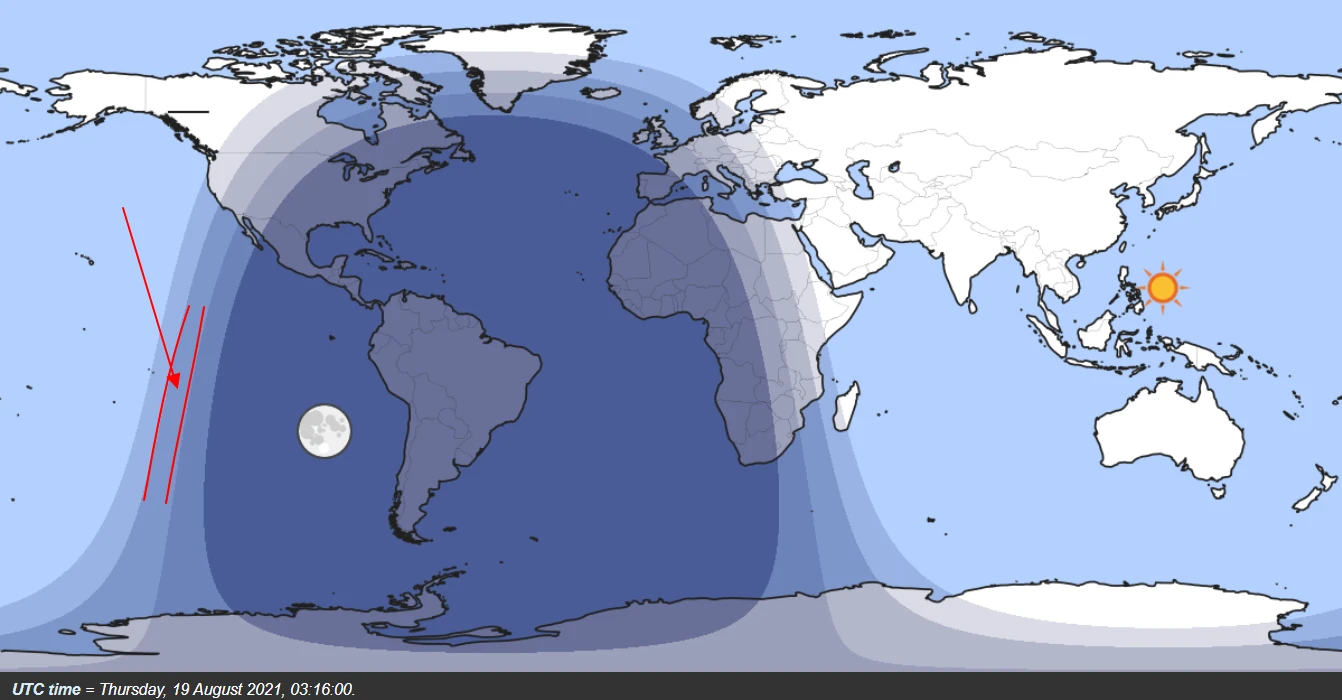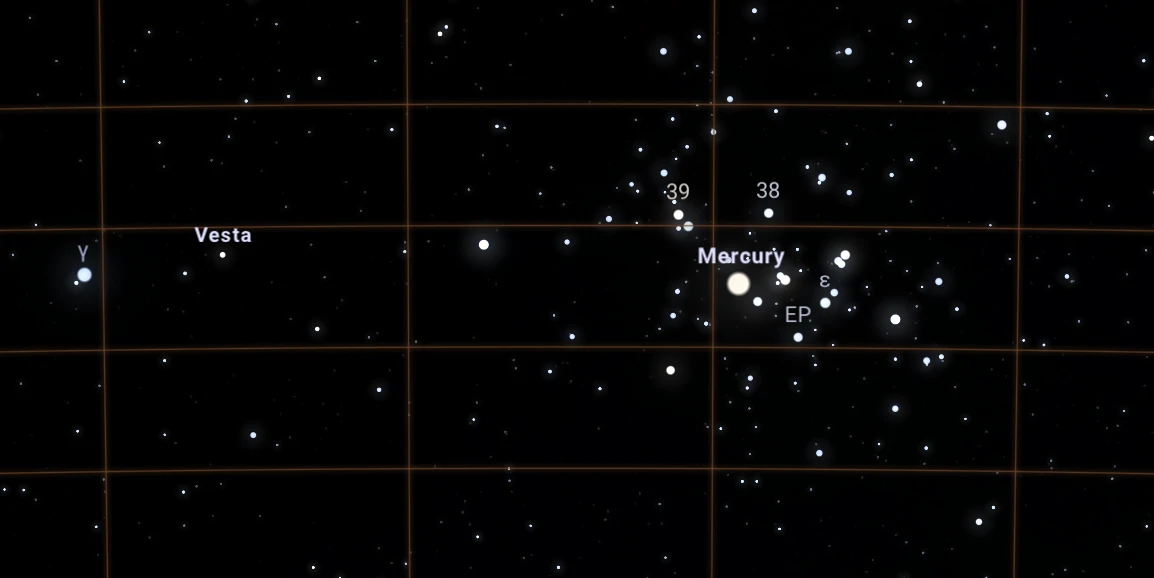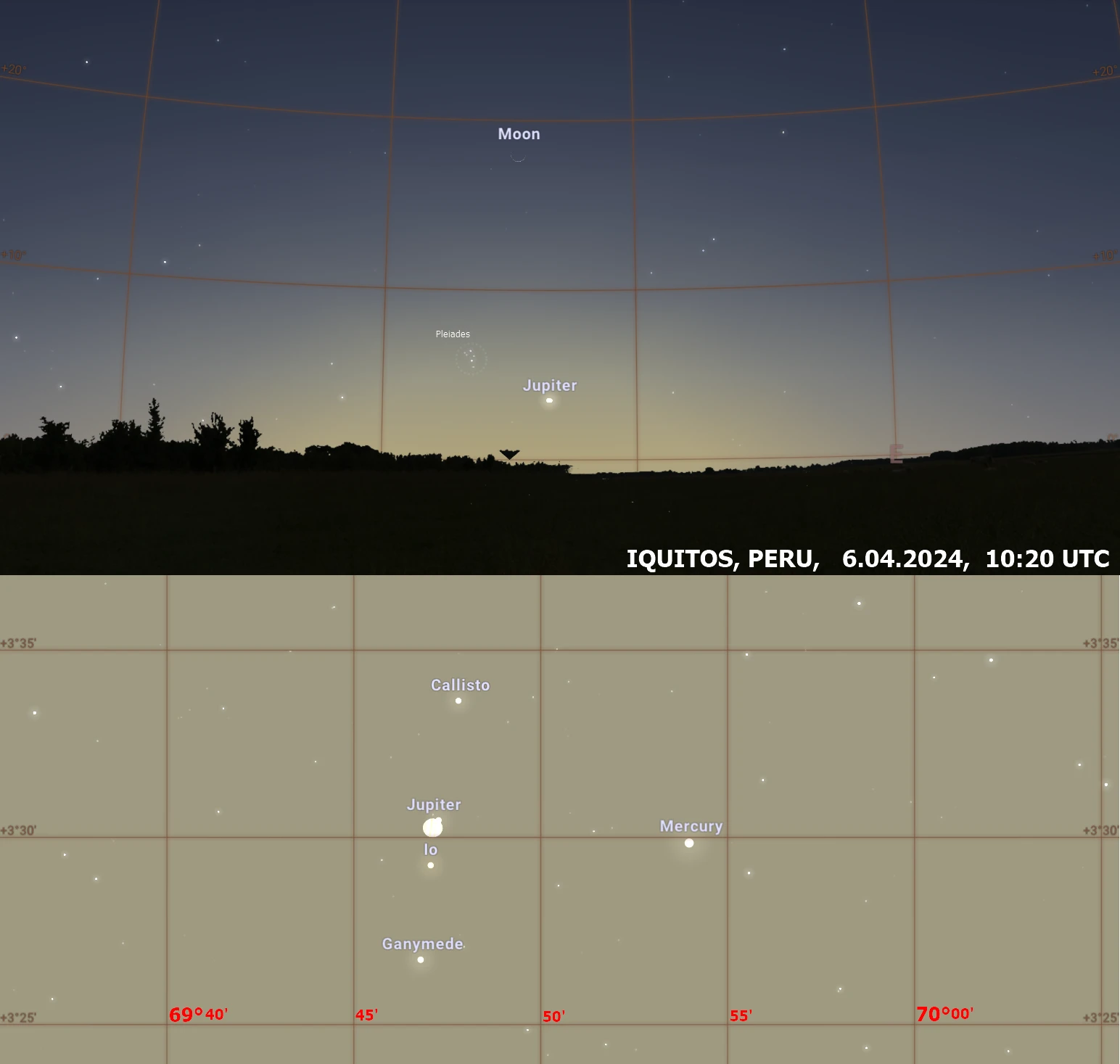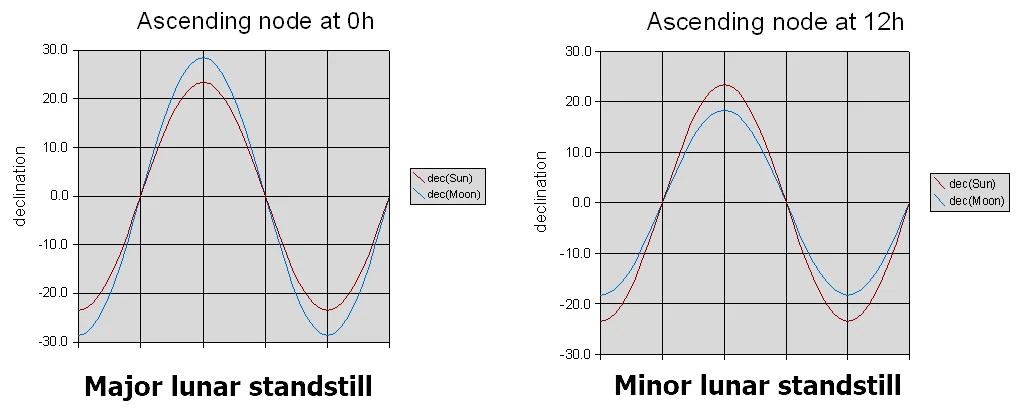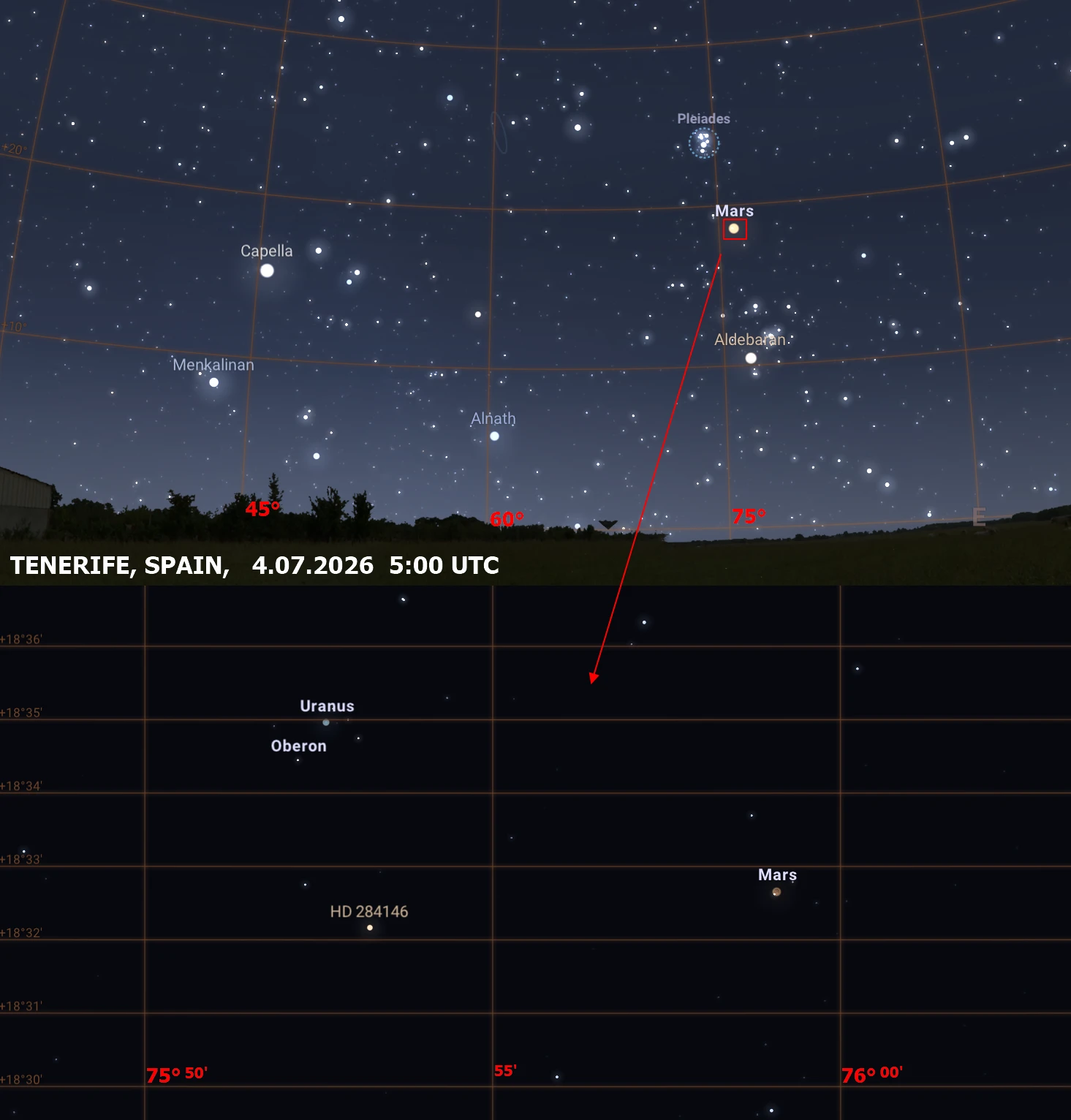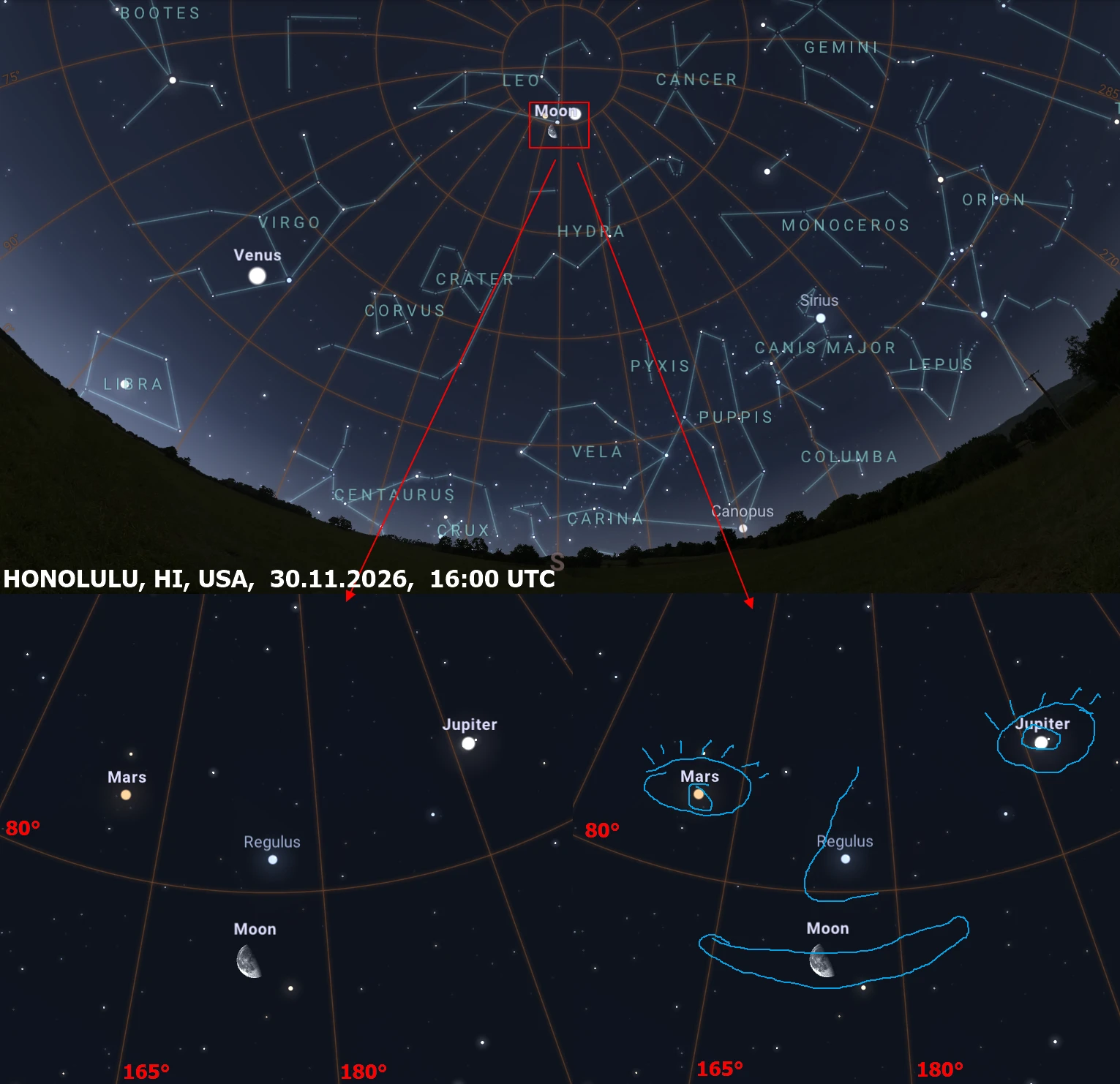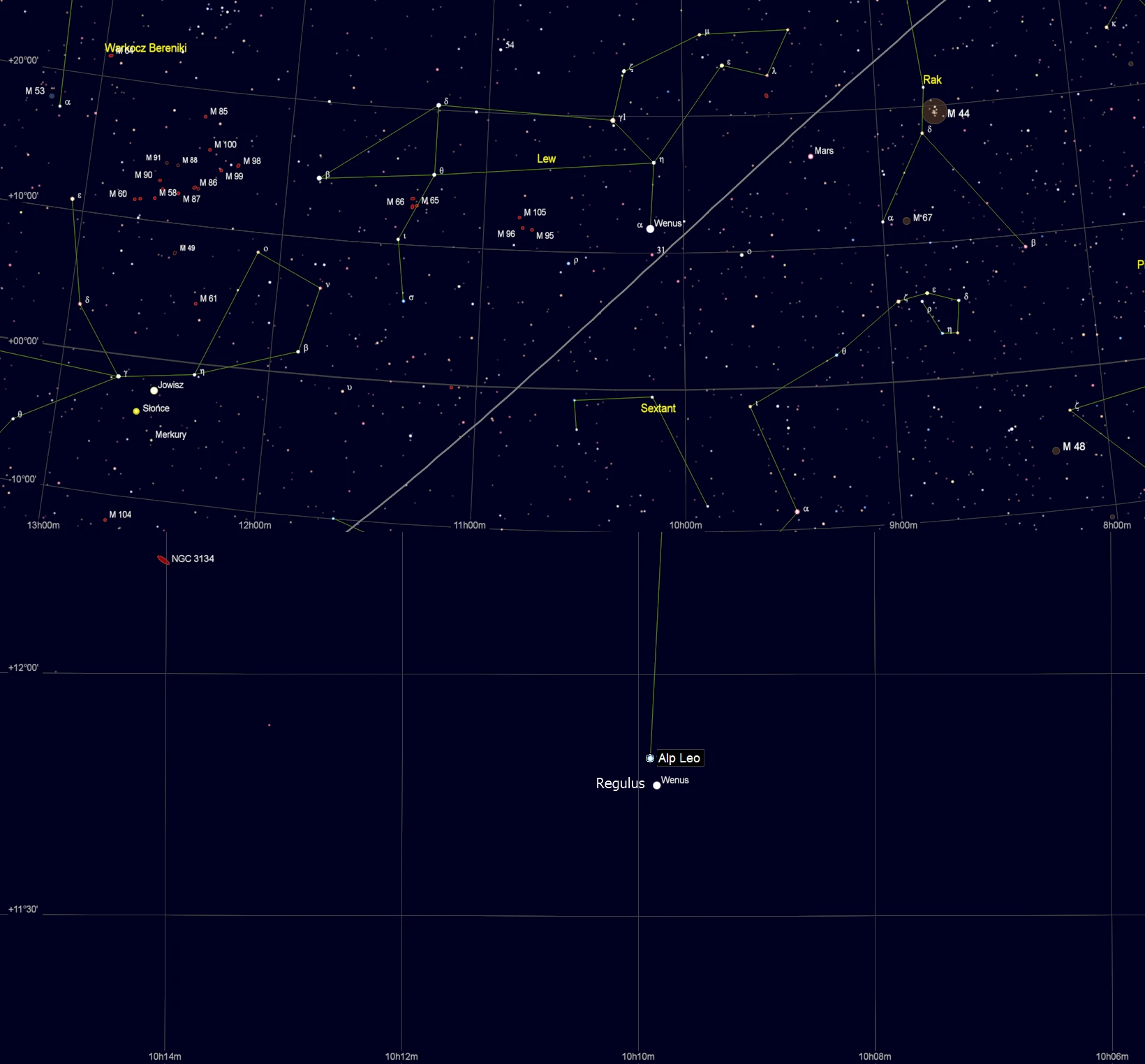The most unique astronomical events you shouldn’t miss in the 2021-2030 decade
Recently we have entered the new decade 2021-2030. This is a good time to take a look at what major astronomical events will occur throughout this time. I don’t mean typical celestial events, as known from a vast majority of astronomical calendars issued usually on a yearly basis. I would like to take a deep look and explain to you the uniqueness of these occurrences combined with their rarity in the sky. All, that I am going to show you below happens usually once a decade, sometimes in pairs. If some type of event is to be observed several times throughout this period, I’ve picked the best one in terms of the configuration and conditions of its observation. I believe, that some of them won’t be mentioned in the typical astronomical calendars, which focus mostly on conjunctions, lunar phases, and so on. The things listed here refer to some types of events possible to see instead of single situations, although some of them appear as single occurrences. By reading this article you can make some long-term plans for astronomical observations, which won’t repeat quite soon.
- THE GREAT CONJUNCTION OF MERCURY AND MARS (19.08.2021)
The conjunction of these 2 bodies occurs in three intervals basically. The most often is the shortest interval between 11 and 82 days, which states 69% of all conjunctions. This period compounds several conjunctions unlike the longest interval, where the conjunction of these 2 planets happens once. Longer intervals count accordingly 628-642 and 713-718 days. These conjunctions feature various angular separations (Pic. 1).
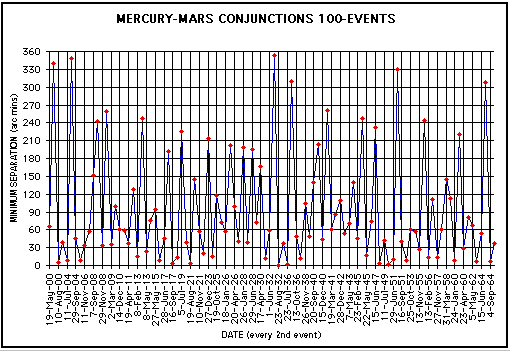
Pic. 1 The pattern of 100 Mercury and Mars conjunctions between AD 2000-2064 with comparison to the minimum separation (arcmin) between these 2 planets (Climate.gi.Alaska.edu).
The graph above shows, that these conjunctions vary between each other regarding the minimum separation of these 2 celestial bodies in the sky. It’s fairly normal, but it’s worth taking a detailed look and checking which conjunctions are the greatest and how often they occur.
By reading this pattern, we should be aware of the coincidence between Mercury’s and Martian orbit mechanisms. Because Mercury orbits Sun every 88 days it’s much quicker than Mars, which does the same within 687 days. The big difference is also in the orbit inclination. Since the Martian orbit is inclined just 1°89′ to the ecliptic, Mercury’s one is inclined by 7 degrees to the Earth’s orbit. Combining all these major factors together, we see the result of various conjunctions possible to see from Earth, where most of them feature at least 30 arcmin separation between these two planets. On average 4 times per decade, these planets can approach closer to each other (between 3 and 5 times within 10 years), whereas, in the span of 4-11-4-13 years, we can watch the “great” conjunctions, where these 2 bodies are as close as 10′ or even closer. This is only a far-reaching simplification, which definitely requires a detailed explanation in the future. For the time being, we can see, that the “great” conjunction of Mercury with Mars happens usually once a decade. It’s a quite rare occurrence then, considering also the general observation conditions. As we know, the best observation of Mercury conditions occurs only when its elongation is close to maximum. In other cases, this planet is usually above the horizon at a small solar depression, which makes it invisible to the observer, because it’s too bright.
The situation is slightly better at lower latitudes, where the ecliptic is more perpendicular to the horizon, but even this won’t help if the angular distance of Mercury to the Sun is too small. These circumstances are reflected in the whole territory, where an event such as this can be observed. Saying the “greatest” conjunction, we understand it as a moment, when both planets are in minimum separation from each other. This “moment” can last about several minutes, thereafter the planets move away from each other. In conclusion, the best conditions for watching a conjunction such as this are usually restricted to a narrow swath somewhere around the globe.
August 19, 2021, will be the day when the “Great” conjunction between Mercury and Mars will occur. Both planets will be separated by 4 arcminutes only (Pic. 2, 3), so about one-third closer than Jupiter and Saturn on December 21, 2020. Moreover, Mercury will be elongated around 16 degrees from the Sun, which means, that the planet should be visible without problems during nautical dusk. Everything would be perfect, but this conjunction can be observed in the narrow path of the South Pacific (Pic. 4,5).

Pic. 2 The Great conjunction of Mercury and Mars on Aug 19, 2021, at Pitcairn (Stellarium-web.org). Click to enlarge.

Pic. 3 The Great conjunction of Mercury and Mars on Aug 19, 2021, in Gambier (Stellarium-web.org). Click to enlarge.
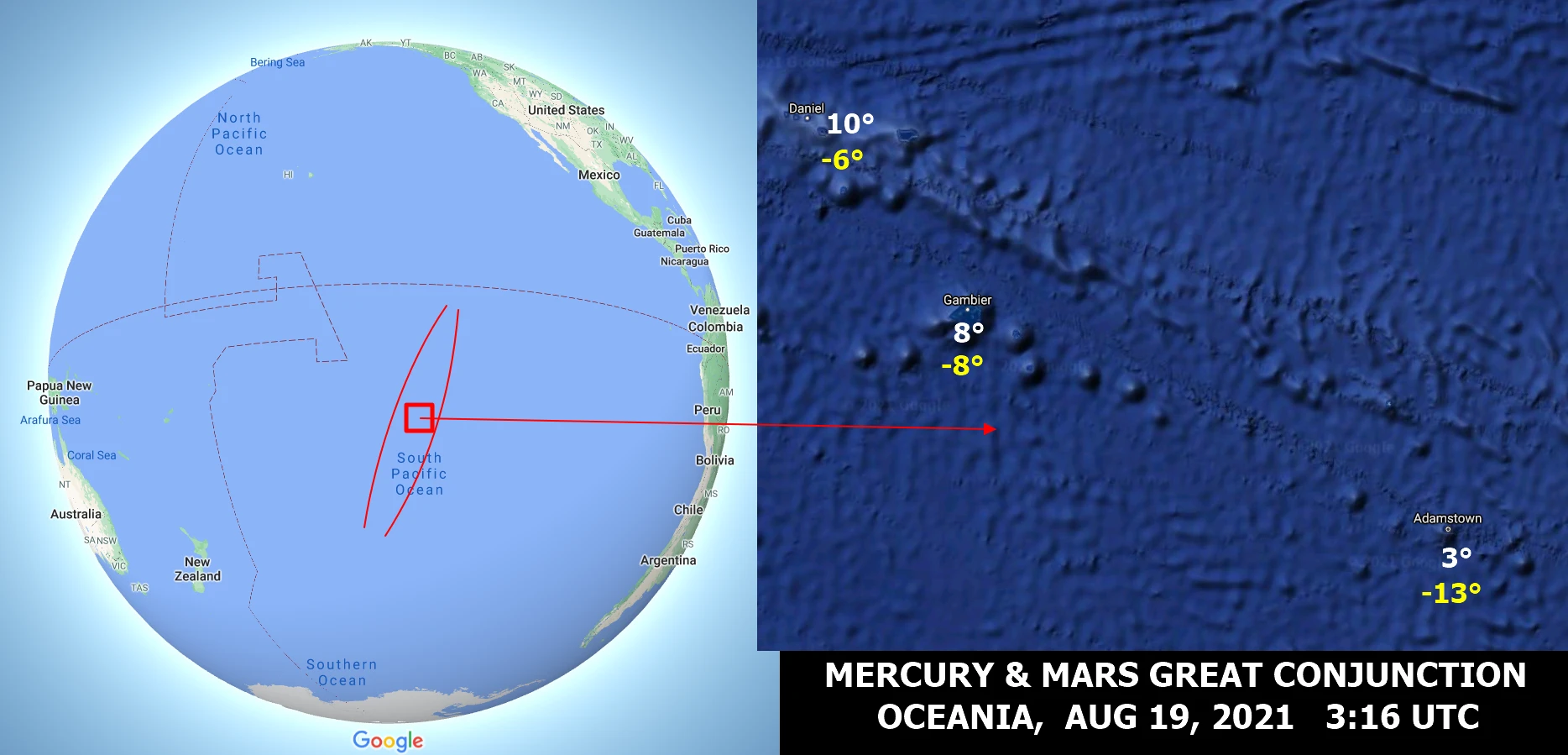
Pic. 4, 5 The best area of visibility of the Great Mercury and Mars conjunction on August 19, 2021, at 3:16 UTC, when the moment of minimum angular separation occurs: 4 – the general view on Day and Night World Map (Timeanddate.com); 5 – The area of visibility in details, where white text shows the elevation of these bodies above the horizon, the yellow text points out the solar depression at this time (Maps.google.com). The red bounds mark the swath with the best conditions of visibility in both images. Click to enlarge.
It doesn’t mean, that no one else will see the conjunction. The moment of the biggest approach will be simply missed in other locations, but the conjunction of these 2 planets will be still visible.
There is also another Mercury and Mars conjunction in the 2021-2030 decade, which is worth attention. Regrettably, the separation will be about 14′ and the distance to the Sun 19° on January 27, 2024. Unfortunately, it will happen at a similar location. The best conditions for watching this conjunction will be at Palmerston Island (Cook Islands), Niue Island (7° above the horizon), American Samoa, Tonga (Vava’u), and Hawaii Island (2-3° above the horizon) (Pic. 6). The highest position of these planets will be at Rarotonga Island (Cook Islands), but the solar depression of 5° might not allow observers to see this spectacular event (Pic. 7).

Pic. 6 The overall map showing the best conditions of watching the biggest conjunction of Mercury with Mars on January 27, 2024, around 15:30 UTC (Timeanddate.com).
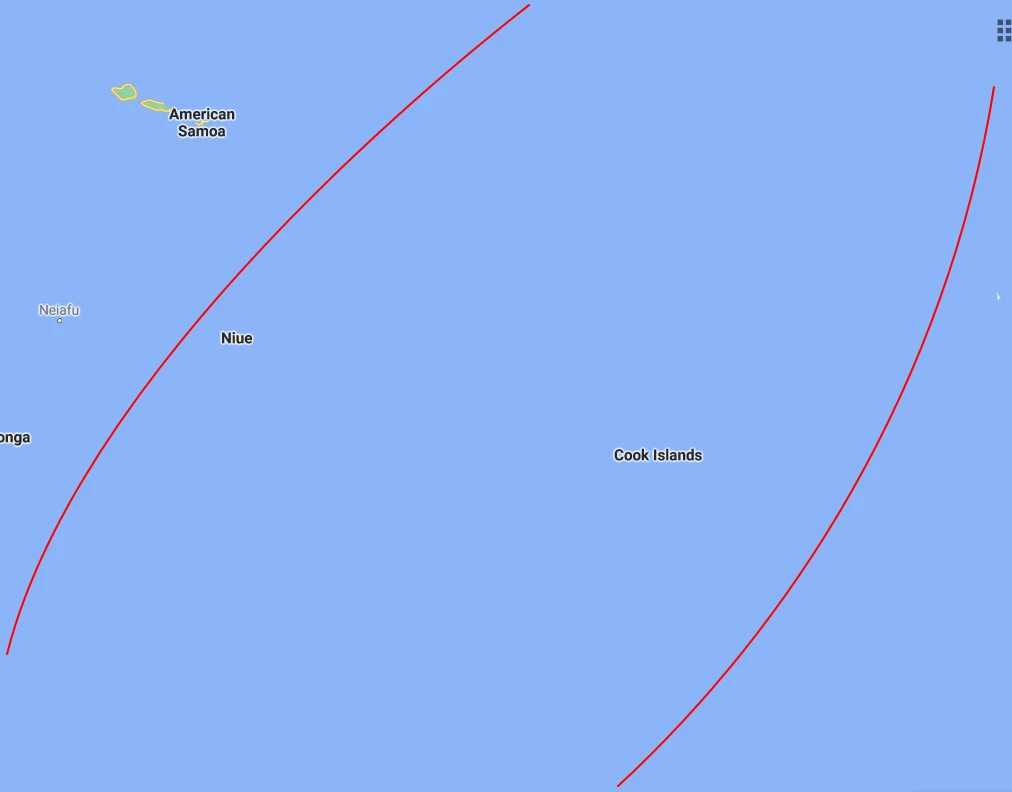
Pic. 7 The area of best visibility is the Mercury and Mars conjunction on Jan 27, 2024, about 15:30 UTC before sunrise. The red line indicates both the altitude of these bodies at least 5° above the horizon and sollar depression not lower than 7° (Maps.google.com).
Below I prepared the small table presenting the circumstances of other “Great” conjunctions of Mars and Mercury up to the year 2064 in relation to the angular distance from the Sun.
Date Angular separation (arcmin) Angular distance from Sun (degrees) 10.08.2000 4 12 11.07.2004 10 21 16.09.2017 3 16 19.08.2021 4 16 23.08.2032 0! 13 23.07.2036 2 20 27.09.2049 2 17 4.09.2064 6 14
The decade 2021-2030 is not the most favorable for events like this, but the next one (2031-2040) will be probably the best in our life. Despite a quite small angular distance between these planets to the Sun, the event will be visible from more favorable locations (western Europe & Africa). The essence of this conjunction requires definitely a big telescope enlargement (Pic. 8).
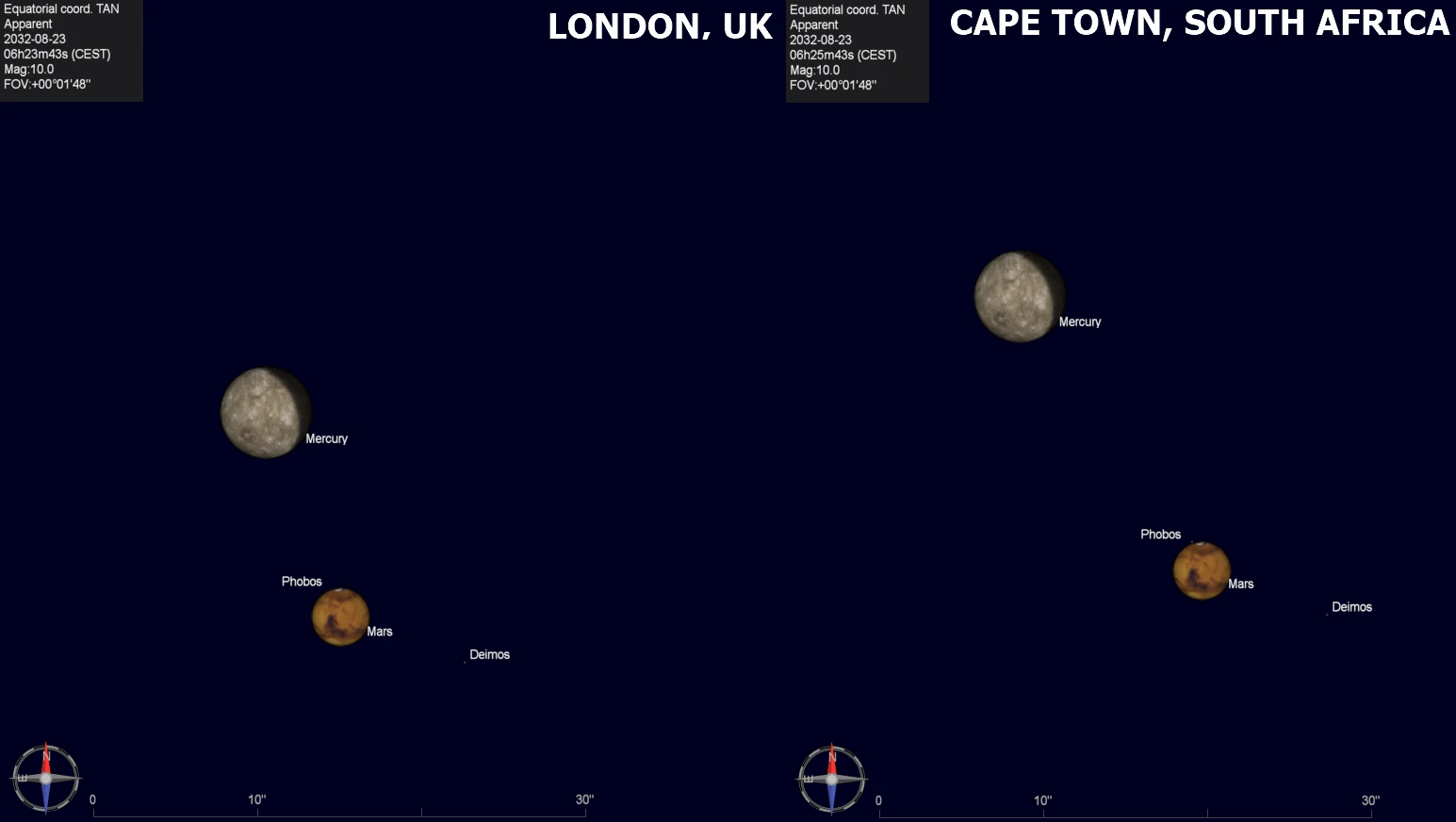
Pic. 8 The greatest conjunction of Mercury and Mars on August 23, 2032. The planets will pass just about 7″ from each other. It means, that they won’t be distracted by the human eye at all. Some significant enlargement is required for this spectacular observation (Cartes du Ciel Sky Charts 4.31). Click to enlarge.
2. ALL PLANETS IN THE SKY (29.05 – 7.07 2022 AND OTHER DATES)
The human eye can see 5 planets without a problem. Uranus is at the edge of the visibility of human sight, and Neptune requires a telescope. I would like to talk mostly about the 5 planets, which were known from ancient times. All these planets are visible throughout the year under various configurations. Sometimes, we can see all of them at the same time, which happens usually at dusk or dawn. Despite this event being quite common, and might occur around 2-5 times per decade, sometimes the conditions are not good enough for some locations around the Globe in spite of its length. Configurations such as this are not one-day events, they are observable at least a few days in a row. The period between May 29 and July 7, 2022, at dawn will be unique. During this period, we should see all the planets in the span of about 120°. Apart from the 5 planets visible, Uranus and Neptune will also align between them. The notable dates throughout this period are determined by major events, which happen somewhat inside of this planet setting:
– May 29 – Mercury reaches 10° angular distance from the Sun, crescent Moon in conjunction with Mercury, and Mars in conjunction with Jupiter,
– June 12 – Venus in conjunction with Uranus
– June 16 – Maximum west elongation of Mercury. The planet will be about 18° from the Sun, but because of its lower declination than the Sun, it won’t be visible well from higher latitudes in the northern hemisphere
– June 19 – Moon approaches Saturn and Vesta
– June 21 – Moon in conjunction with Neptune and Jupiter
– June 22 – Moon in conjunction with Jupiter and Mars, Mercury in the Hyades at the opposite side to Aldebaran, Venus near the Pleiades. This is the best day to watch all these bodies (Pic. 9,10)

Pic. 9 All planets in the sky with the accompany of the Moon on June 22, 2022. The view is considered from 3 locations on the Earth (Stellarium-web.org). Click to enlarge.

Pic. 10 An interesting configuration on June 22 is possible to see from lower latitudes, where Mercury will build up an opposite frame of the Hyades (Stellarium-web.org). Click to enlarge.
– June 23 – Moon in conjunction with Mars
– June 23,24 – Venus near the Pleiades
– June 25 – Moon in conjunction with Uranus
– June 26 – July 3 – Mercury at the highest altitude at Sunrise from the northern hemisphere (Pic. 11)
– June 27 – crescent Moon in conjunction with Mercury
– July 7 – Mercury is as close as 10° to the Sun, remaining visible shortly before sunrise from the equator.
Another period, when a situation such as this occurs is between November 28, 2022, and January 2, 2023. During this period, we also can see all the planets in the sky, but their configuration is worse than a half-year earlier. The planets are scattered across the whole sky. Mars is far away above the eastern sky. The notable dates within this period are:
– November 29 – the conjunction of the Moon with Saturn
– December 1 – the conjunction of the Moon with Jupiter and Neptune
– December 5 – the conjunction of the Moon with Uranus
– December 7 – the conjunction of the Moon with Mars
– December 24 – the conjunction of the Moon with Mercury and Venus
– December 26 – the conjunction of the Moon with Saturn
– December 28 – the conjunction of the Moon with Neptune
– December 29 – the conjunction of the Moon with Jupiter
– January 1 – the conjunction of the Moon with Uranus
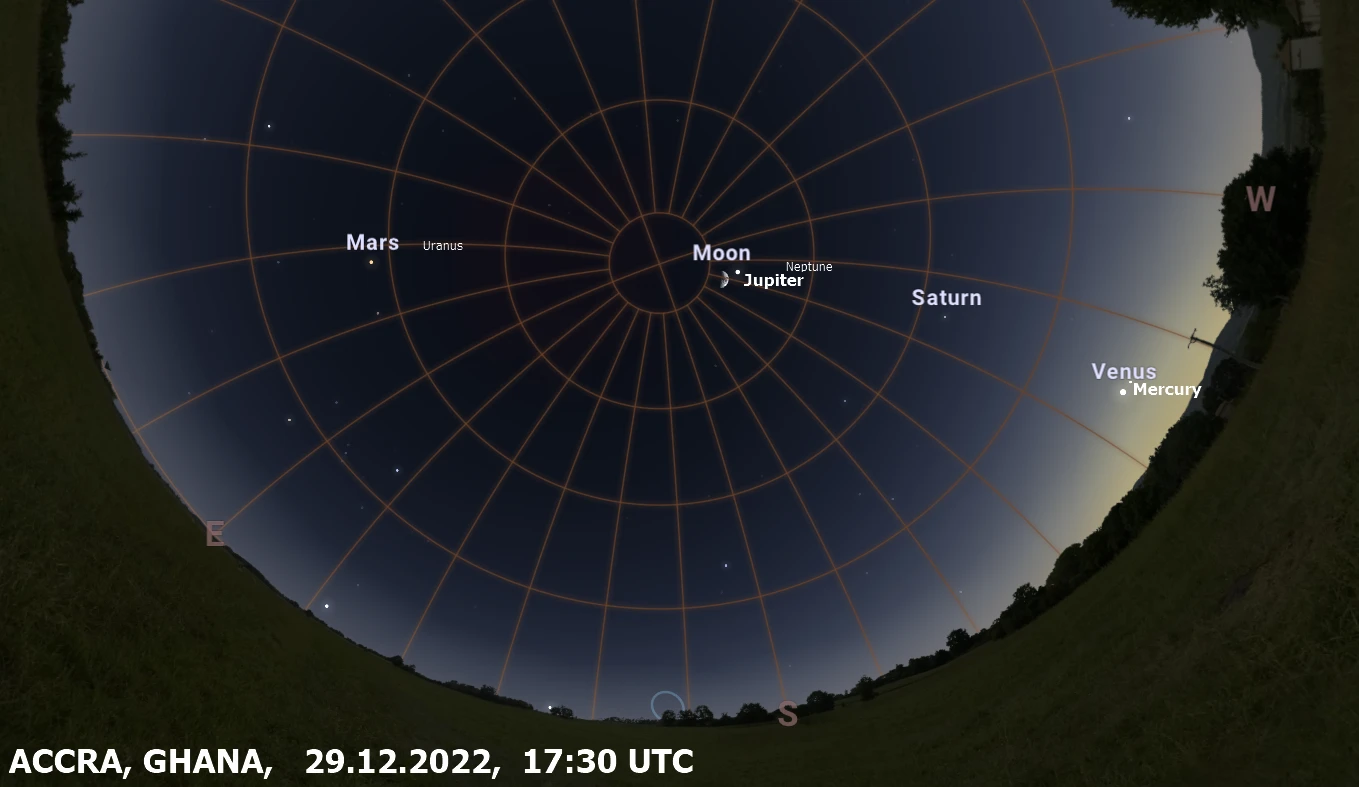
Pic. 12 All planets in the evening sky on December 29, 2022, when the Moon approaches Jupiter. The view from near-equator locations (Stellarium-web.org). Click to enlarge.
This configuration will work for lower latitudes. At higher latitudes, Mercury and Venus will be quite low according to altitudes 9 and 7° above the horizon at the moment of sunset.
Next, the possibility of seeing all the planets in the sky falls in late February 2025. This is the last week between February 21 and February 28 and regrettably, the conditions seem to be not good enough, because of Saturn, which angular distance to the Sun reduces significantly every day.
Important dates might be:
February 25 – the Mercury and Saturn conjunction. Both planets will be as far as 13° away from the Sun, so the observation is going to be hard from higher latitudes.

Pic. 13 All planets in the evening sky on February 25, 2025, the day of the conjunction of Mercury with Saturn low above the horizon after sunset. The view from near-equator locations (Stellarium-web.org). Click to enlarge.
February 28 – the crescent Moon will pass Saturn, located barely 10° from the Sun. The event will be possible to see only from lower latitudes then. The conjunction of Mercury with Neptune on March 2 won’t be visible at all, as these planets are only in the separation of 9° from the Sun.
Another period, slightly better for observers falls between October 10 and November 4, 2028, when we will also see all the visible planets in the sky. This time, Neptune is about to set, when Mercury and Jupiter are visible just above the eastern horizon. Traditionally, equatorial locations are the best. The most important dates to point out here are:
October 14 – Jupiter 10° from the Sun. Because this is the second brightest planet in the sky (except Mars near the great opposition) it should be visible a few days earlier (at least from October 10). Jupiter passes the Porrima star (γ Virginis).
October 14 – the conjunction of the Moon and Mars
October 15 – the conjunction of the Moon and Venus
October 17 – the conjunction of the Moon and Jupiter
October 22 – the conjunction of Mercury and Jupiter – a very well-located event, as far as 17° from the Sun, so it will be visible yet from astronomical dawn (Pic. 14)

Pic. 14 All planets in the evening sky on October 22, 2028, when Jupiter is in conjunction with Mercury. The view from near-equator locations (Stellarium-web.org). Click to enlarge.
November 2 – the conjunction of Moon and Saturn
The last period with all (at least visible) planets present at the same moment in the sky falls between April 11 and April 24 in 2029. This time, Neptune is under the horizon. The whole situation is rescued by Venus, which, as an unusually bright planet (even when passes exterior conjunction with the Sun) can be easily spotted straight after sunset (not to mention, that technically it would be visible for the entire day, but it seems to be still too close to the Sun). On the other hand, the visibility of Saturn is getting worse day by day as the Planet reduces its distance to the Sun. The most important dates within this period can be:
April 11 – Venus 5° from the Sun
April 14 – Moon passes Venus, a quite nice configuration of Venus, Saturn, Mercury, and Moon. All these bodies will shape the trapezium in the sky, but too close to the Sun, which makes it hard to spot even from equatorial locations (Pic. 15).
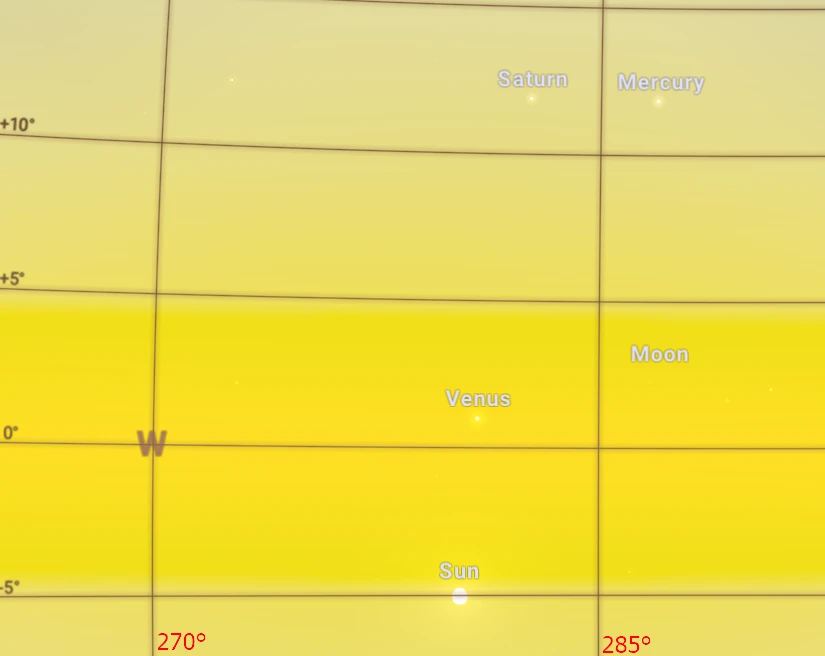
Pic. 15 The “trapezium” conjunction of Moon, Venus, Saturn, and Mercury is possible to see from Ghana when the Sun is just 5° below the horizon (Stellarium-web.org).
April 15 – Saturn, Mercury, and the crescent Moon in one line, at a 16-18° distance from the Sun
April 17 – the conjunction of the Moon and Uranus
April 24 – the conjunction of Venus and Saturn, just 7-8° from the Sun (Pic. 16)
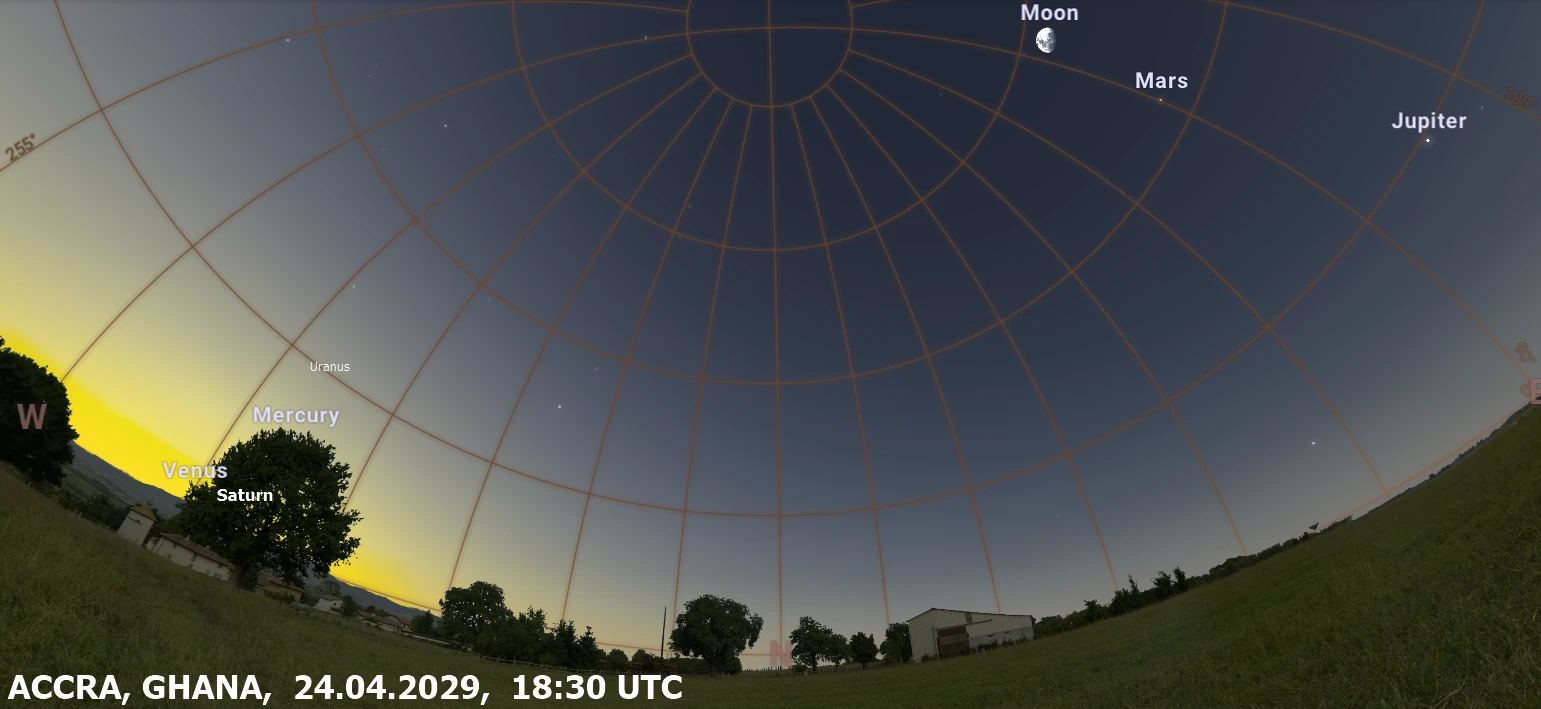
Pic. 16 All planets in the evening sky on April 24, 2029 – the day when Venus is in conjunction with Saturn. The view from near-equator locations (Stellarium-web.org). Click to enlarge.
Concluding, the period between May 29 and June 27, 2022, is the best for watching all the planets at the same time. Regardless of the overall frequency of configurations such as this across the decade (usually between 2 and 5 and sometimes in pairs after about half a year), usually, only one or at most two are really worth attention and can be observable from the majority of the locations worldwide.
3. MERCURY & VENUS & MARS IN BEEHIVE CLUSTER (PRAESEPE, M44)
The Beehive Cluster (Praesepe, M44) is located in the Cancer constellation. This is an open cluster with a total brightness of 3.5 Mag. This is one of the nearest open clusters to Earth. Under dark skies, it looks like a small nebulous formation. Because of its location near the ecliptic, the M44 is often visited by the planets. In the 2021-2030 decade, we will have an occasion to see mostly Mars within this cluster. Apart from Mars, Venus and Mercury will be also visible but not as many times as the first one. On August 6, 2026, also Jupiter will be transiting the M44 object, although it will happen just 5 degrees from the Sun, excluding the observation completely.
Despite the big frequency of conjunctions, or saying better, transits of the planets across the M44, the spectacle will be clearly visible only a few times. For instance, Mercury will visit the Beehive cluster twice, in 2023 and 2024 (Pic. 17), but the first time, the planet will be just 14 degrees from the Sun. In this case, the phenomenon can be barely visible from equatorial latitudes, just before nautical dusk ends. On July 6, 2024, Mercury’s transit across the M44 will be so spectacular, because the first planet will be about 24 degrees from the Sun accompanied by Vesta (Pic. 18). On the other hand, Mercury’s stay in M44 is not a long-lasting event. The whole visitation will last up to a few hours, therefore the best visibility will fall within some restricted areas (Pic. 19).

Pic. 17 The Mercury transit across the Beehives (M44) cluster in 2023 and 2024 (Stellarium-web.org).
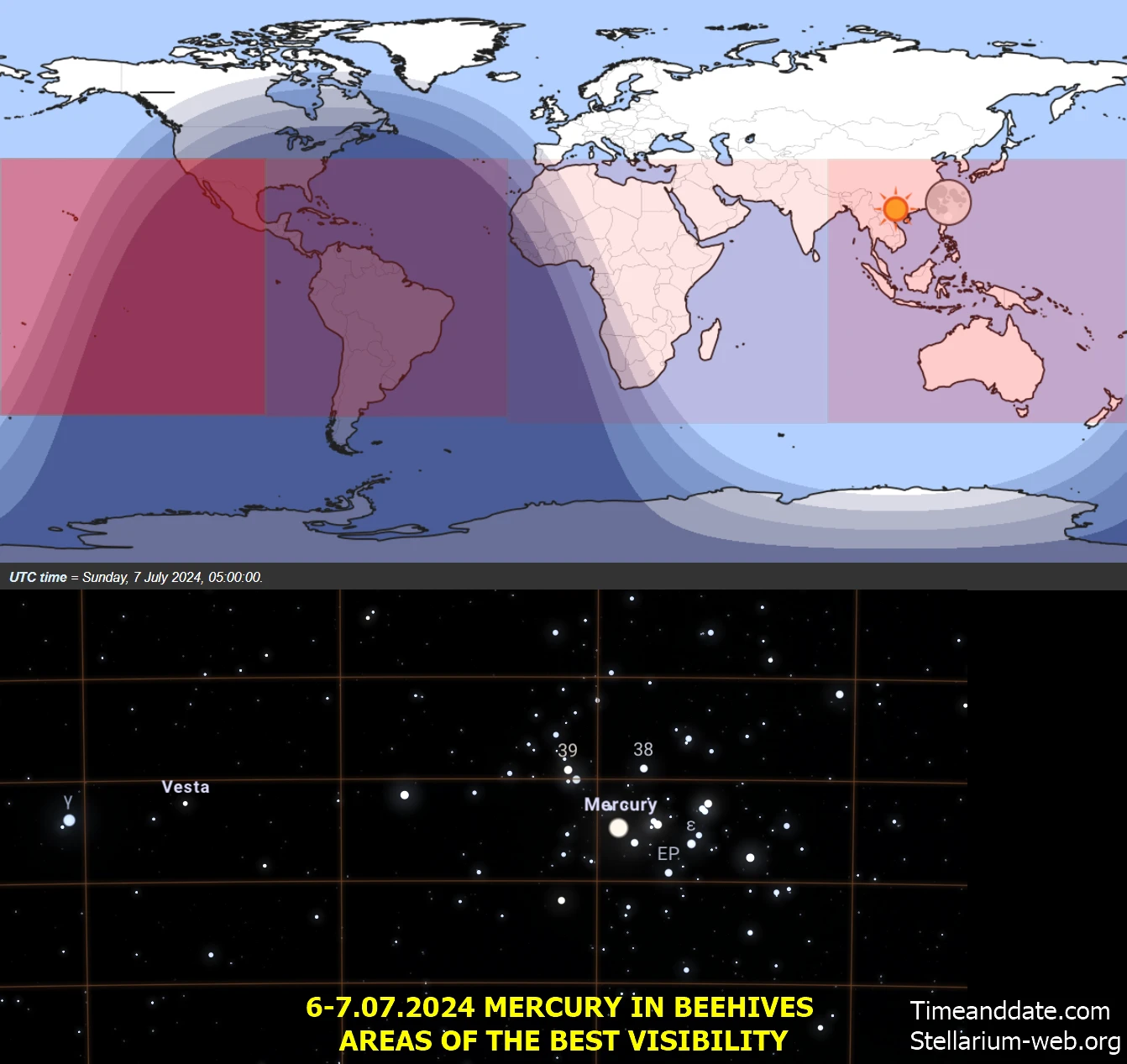
Pic. 18, 19 – The position of Mercury in the Beehives (M44) cluster accompanied by Vesta (18) and the best area of visibility (19), where the most opaque rectangle shows the best conditions to see the event (Mercury plunged into M44)(Timeanddate.com/Stellarium-web.org).
Venus will pass the M44 effectively thrice throughout this decade. Regrettably, all the events will take place quite close to the Sun, because of the date (July 2-3). The best transit of the brightest planet across M44 will occur on July 18, 2024, but only 11 degrees from the Sun. Thereby, there’s rather no chance to see the cluster in the still-bright nautical twilight sky. Anyhow, the configuration of Venus’s orbit remains unfavorable for observations such as this. This planet can be seen only when passes the Beehive cluster more externally, or completely outside (Pic. 20). The conjunction with the M44 cluster repeats every 8 years and belongs to the descending-node transits orbit of Venus like the conjunction with Pleiades and Regulus discussed later.

Pic. 20 The passing of Venus across the Beehives (M44) cluster in the span of 480 years. The track from 1781 corresponds to the situation in 2024 (Cartes du Ciel Sky Charts 4.21).
There are 2 days in the current decade when an event such as this can be observed. It’s July 3, 2021, and July 2, 2029 (Pic. 21). In both cases, Venus will be as far as 25 degrees from the Sun, which makes our observation successful. However, same as in the case of Mercury, this is not a long moment, when Venus can be seen within the cluster. Because the planet passes away from the cluster center, its presence won’t be longer than a few hours. It fairly restricts the area, where this spectacular event can be seen (Pic. 22).
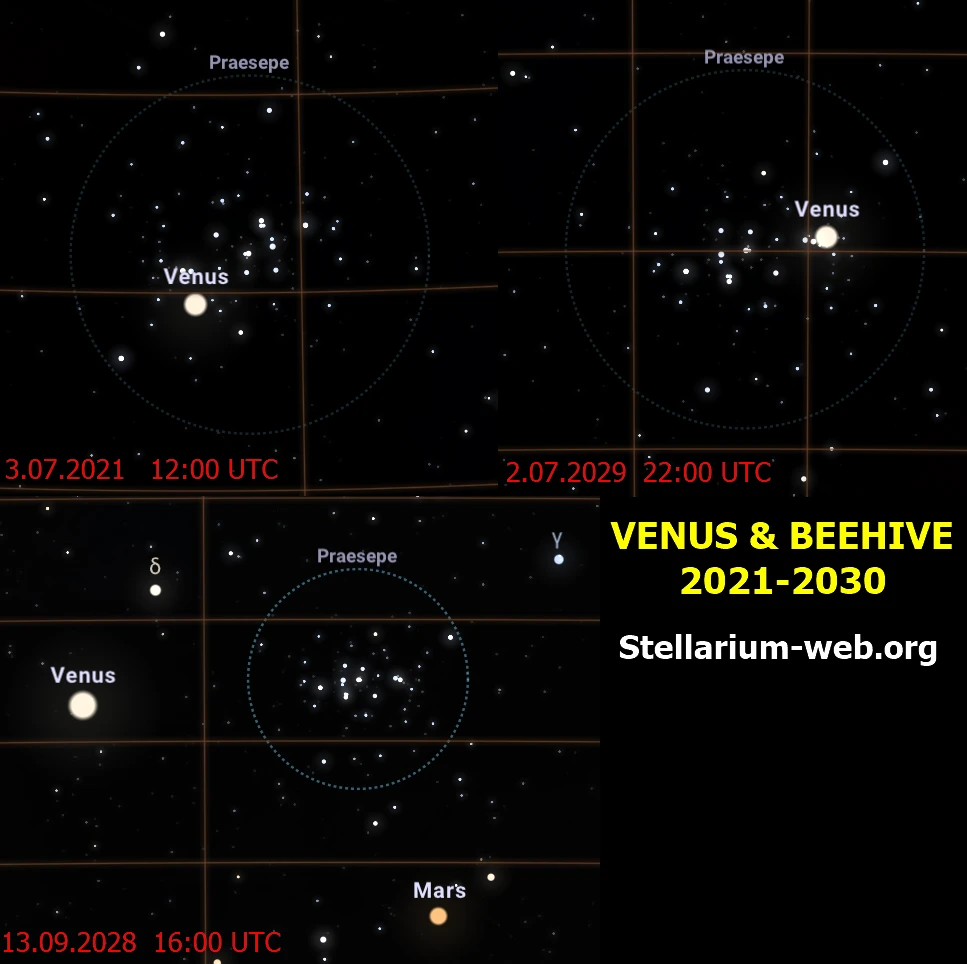
Pic. 21 Venus passing the Beehive (M44) cluster in 2021 and 2029. Another conjunction with the Beehives cluster and Mars occurs in 2028, making the “triangle” (Stellarium-web.org).
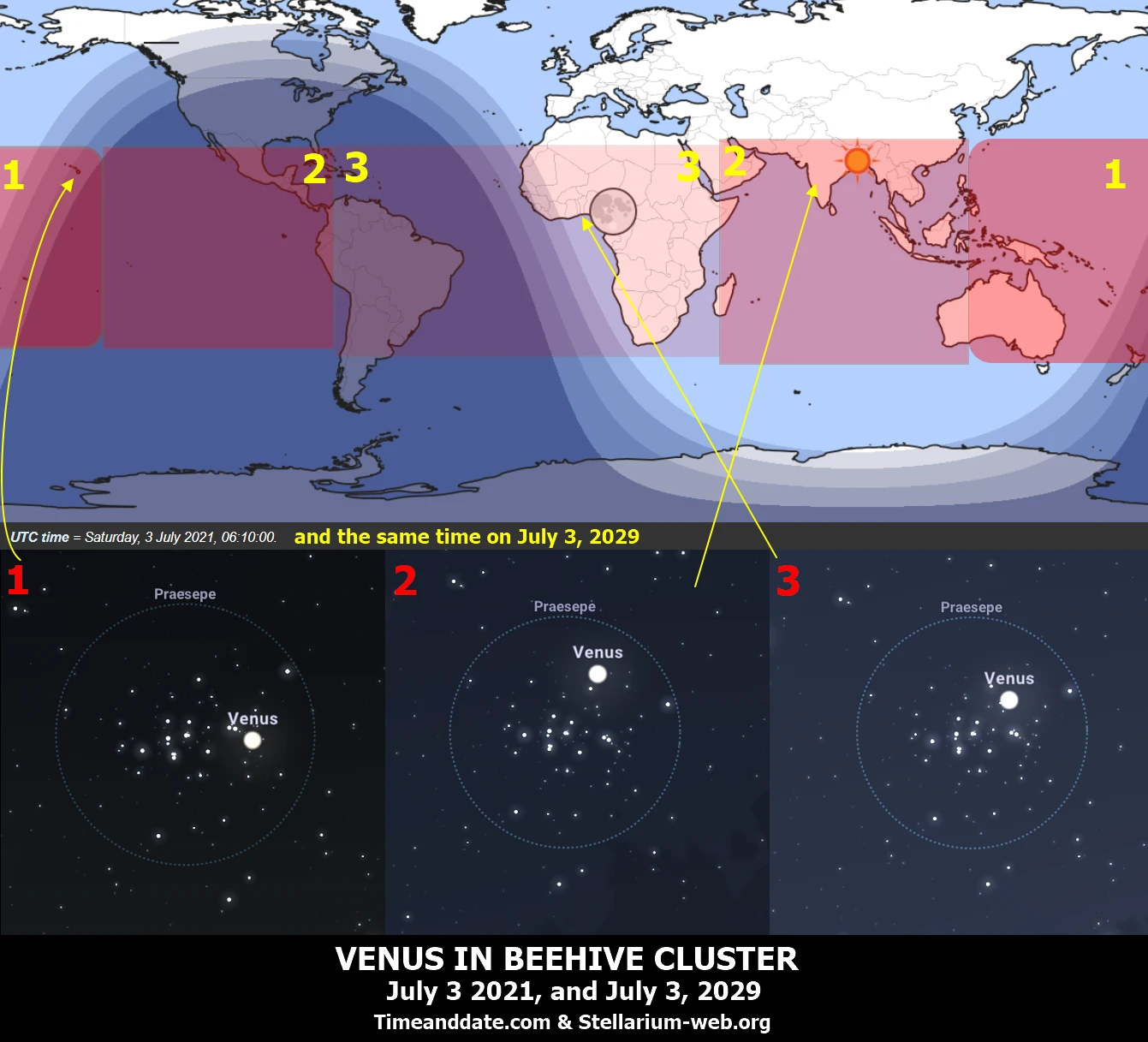
Pic. 22 Venus in Beehive (Praesepe) (M44) cluster and its estimated best visibility worldwide, where: 1 – the most opaque block displays the region with the most favorable conditions to see this spectacular event; 2 – less favorable conditions to see (planet inside the cluster partially above the horizon); 3 – the worst conditions to see this event (the planet passes the M44 Praesepe cluster predominantly below the horizon) (Timeanddate.com/Stellarium-web.org). Click to enlarge.
Besides the situations, when Venus passes the cluster, there are also a lot of moments of conjunction between this planet with the Praesepe. The most spectacular conjunction will occur on September 13, 2028 (Pic. 21) and will be visible perfectly above Horizon far before the crack of dawn (Pic. 23).
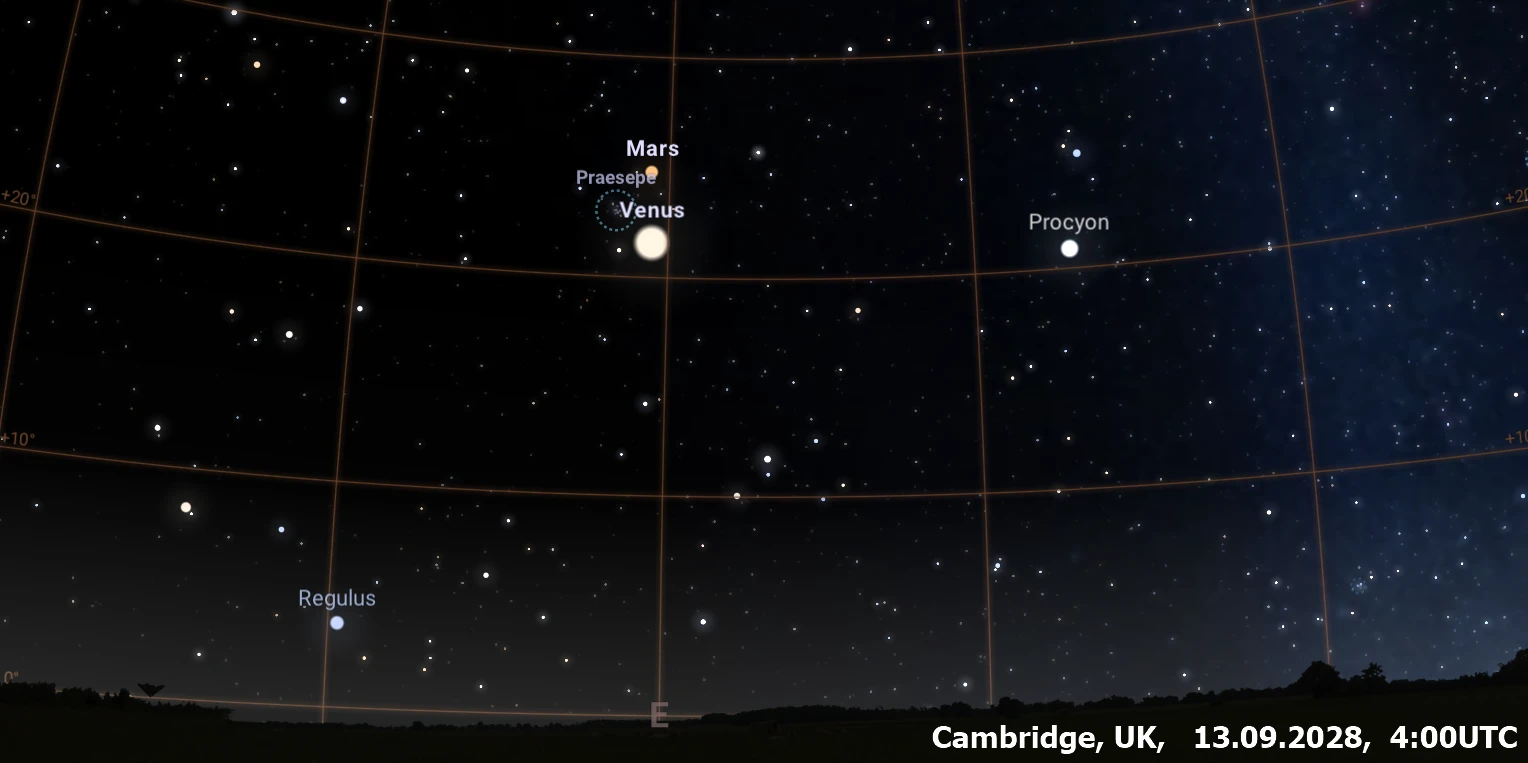
Pic. 23 The conjunction of Venus and Mars with the Beehive cluster (M44) on September 13, 2028, before sunrise (Stellarium-web.org).
Mars is the most common visitor of the Praesepe (M44) cluster. Below I’ve listed the best central passes of this planet between 2021-2030 (Pic. 24).
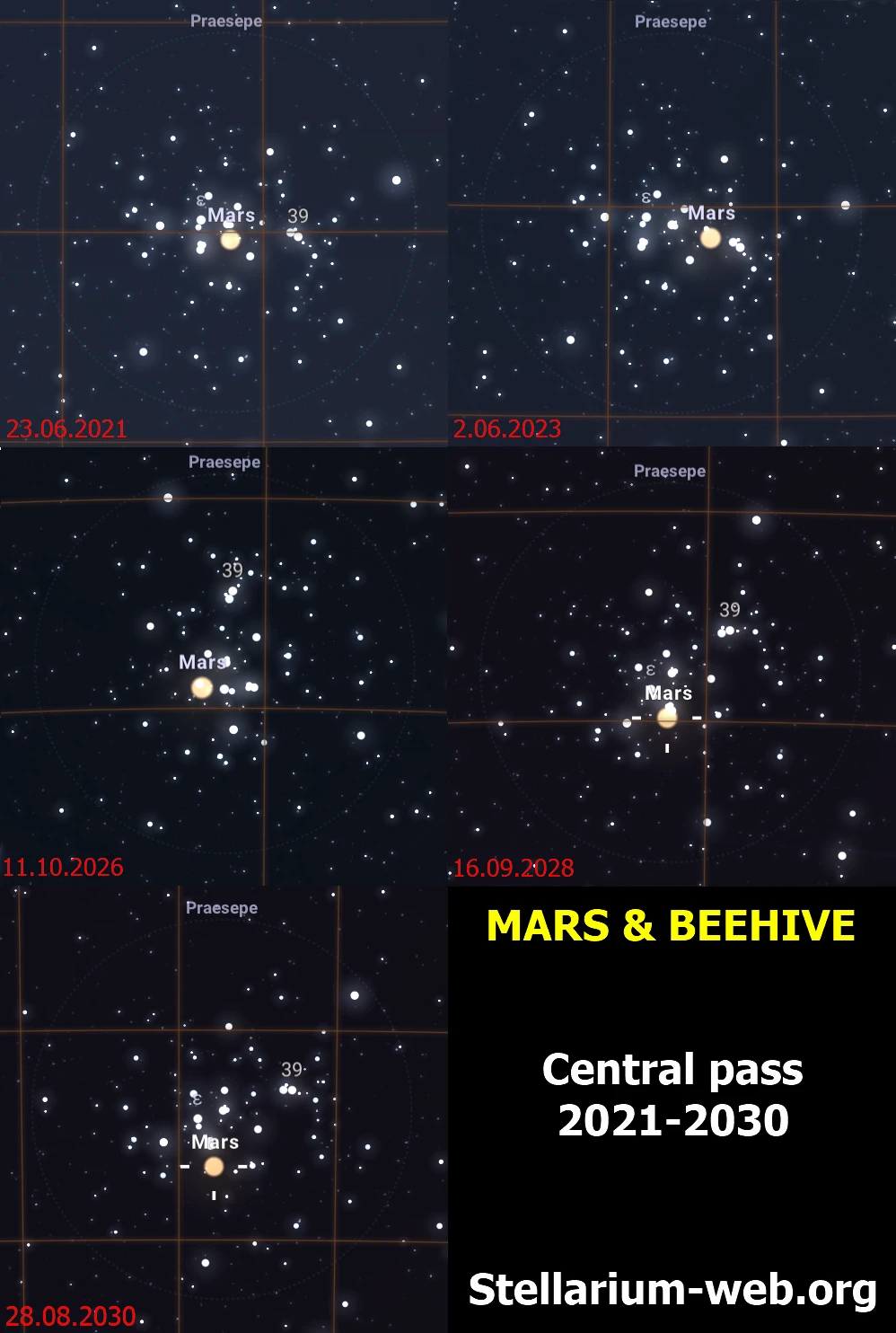
Pic. 24 Mars in Beehives (Praesepe, M44) – central passes between 2021 and 2030 (Stellarium-web.org).
Frankly, all these events will be easily observable worldwide under dark skies, except for the first and the last ones. On June 23, 2021, Mars will be quite close to the Sun (35 degrees). The best conditions to observe the event will fall at tropic, equatorial, and southern latitudes. August 27, 28, 2030 will be even worse, as the planet is located 25 degrees from the Sun only. This time northern hemisphere will experience better conditions.
There is another transit of Mars across the M44 Beehive cluster, although not central this time. It will occur on May 5, 2025. A day earlier these 2 objects will be accompanied by Moon (Pic. 25) with the best approach visible from the western hemisphere (Latin America) (Pic. 25).
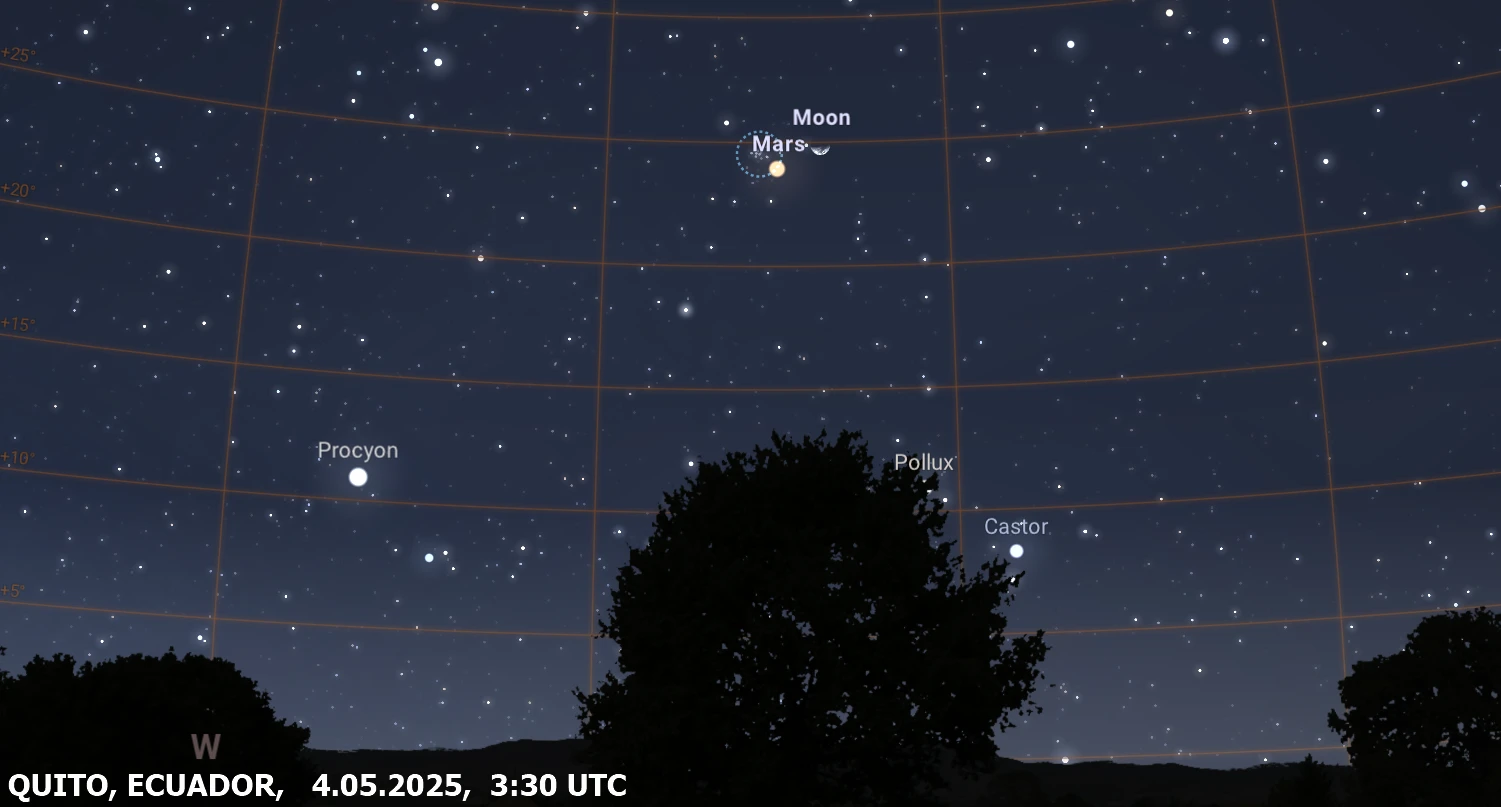
Pic. 25 The conjunction of Mars, M44 Beehive cluster, and Moon on May 3-4, 2025 (Stellarium-web.org).
In conclusion let’s see all passing of the Red Planet across the M44 Beehive cluster between 2021 and 2030 (Pic. 26).
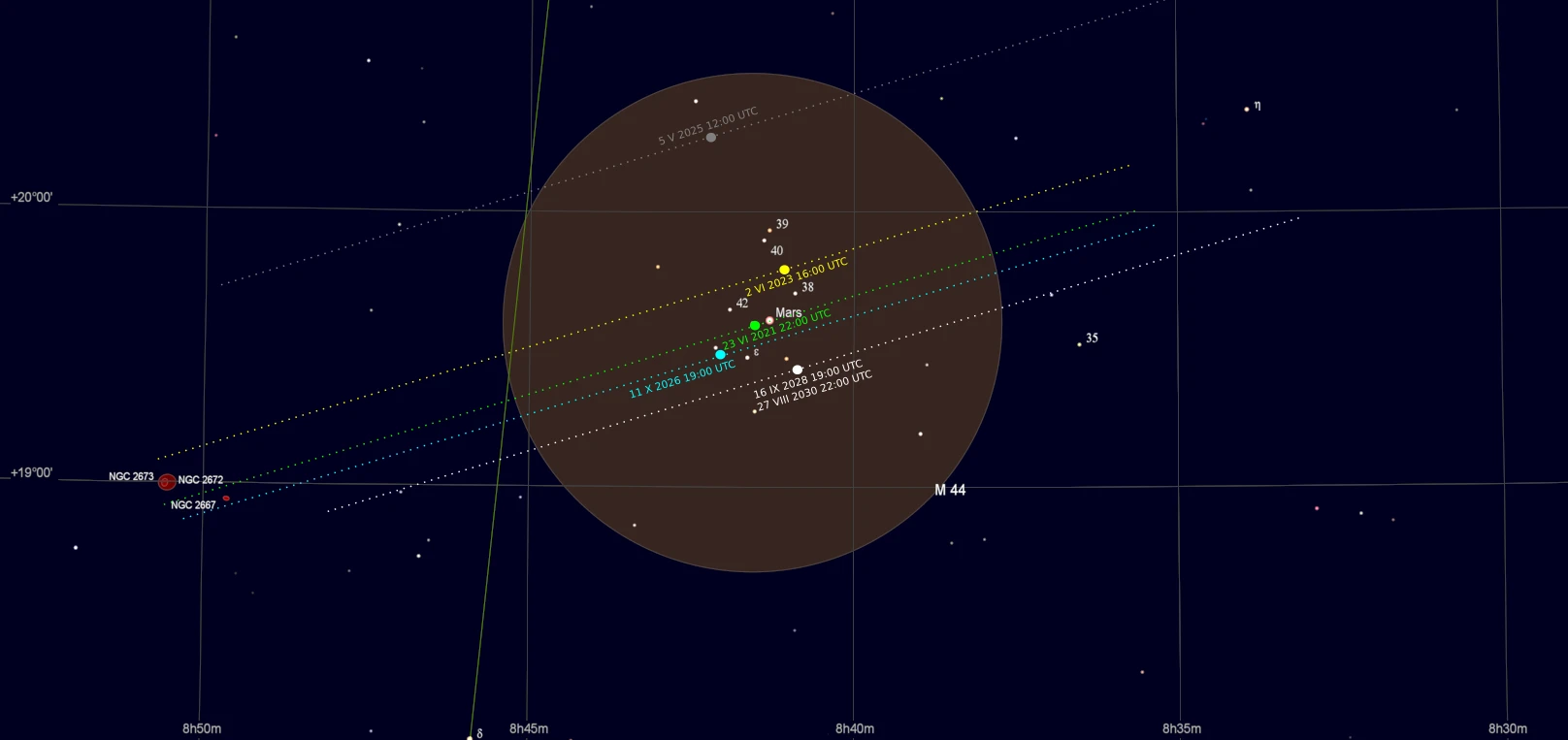
Pic. 26 All passes of Mars across the M44 Beehive cluster in the 2021-2030 decade (Cartes du Ciel Sky Charts 4.21). Click to enlarge.
4. LUNAR OCCULTATIONS OF PLANETS
The lunar route across the sky is very interesting. The orbit of the Moon is inclined by more than 5 degrees. As a result, our natural satellite can occult some celestial bodies located a bit outside of the ecliptic line. Even if the lunar orbit is perfectly aligned with the Earth’s one, the angular diameter of this body means, that always something will be hidden behind it. Both stars and planets, which encounter the Moon on their celestial track, disappear for a moment (usually several hours). The lunar occultations of the brightest stars will be discussed in further readings, as it requires an additional study about the lunar standstill. Another reason, why I haven’t included them here is that they aren’t so spectacular in my point of view. Nevertheless, I haven’t forgotten about them and they will be definitely discussed. The basic difference between the stars and planets, even these ones, located far away from Earth, like Uranus or Neptune, is their angular dimension. Since a star acts like a point in the sky, the planet is like a disk. It means, that the occultation of the planet won’t be just a single moment counted in milliseconds, but a long enough period of time to enjoy it through the telescope. At significant magnifications, we can see how the planet “sets” or “rises” behind the lunar disk, which at vast enlargements performs such a ground instead. In the case of stars, they can at most blink, when the occultation has grazing character. Otherwise, they disappear and reappear suddenly.
Below I have gathered all of the planet occultations by the Moon, which will happen in the current decade. For all visible planets, the daily occultations have been included, because these planets are bright enough to spot them accompanied by an approaching lunar disk when the sky is enlarged enough. Uranus and Neptune’s occultations were considered only for nighttime conditions.
Considering every single planet, we have about 15-20 events on average in the span of the forthcoming 10 years, as you can see below:
LUNAR OCCULTATIONS OF THE SOLAR SYSTEM PLANETS IN 2021 - 2030 DECADE
PLANET NUMBER OF EVENTS
VISIBLE DAYLIGHT TOTAL
Mercury 3 18 21
Venus 11 9 20
Mars 16 8 24
Jupiter 11 4 15
Saturn 11 1 12
Uranus - - 23
Neptune - - 14
We should be aware, that finally, certain locations worldwide can experience no more than one-third of them in extremely favorable situations. Usually, the event occurs about 2-3 times per decade, while in daylight conditions. It stresses the rarity of opportunities for watching it. Furthermore, in a lot of areas, there is no lunar occultation of the particular planet throughout the given period of time, i.e., Mercury from the Sahara, Jupiter from Central Europe, Venus from the Cape York Peninsula, and so on (Pic. 27 – 33).
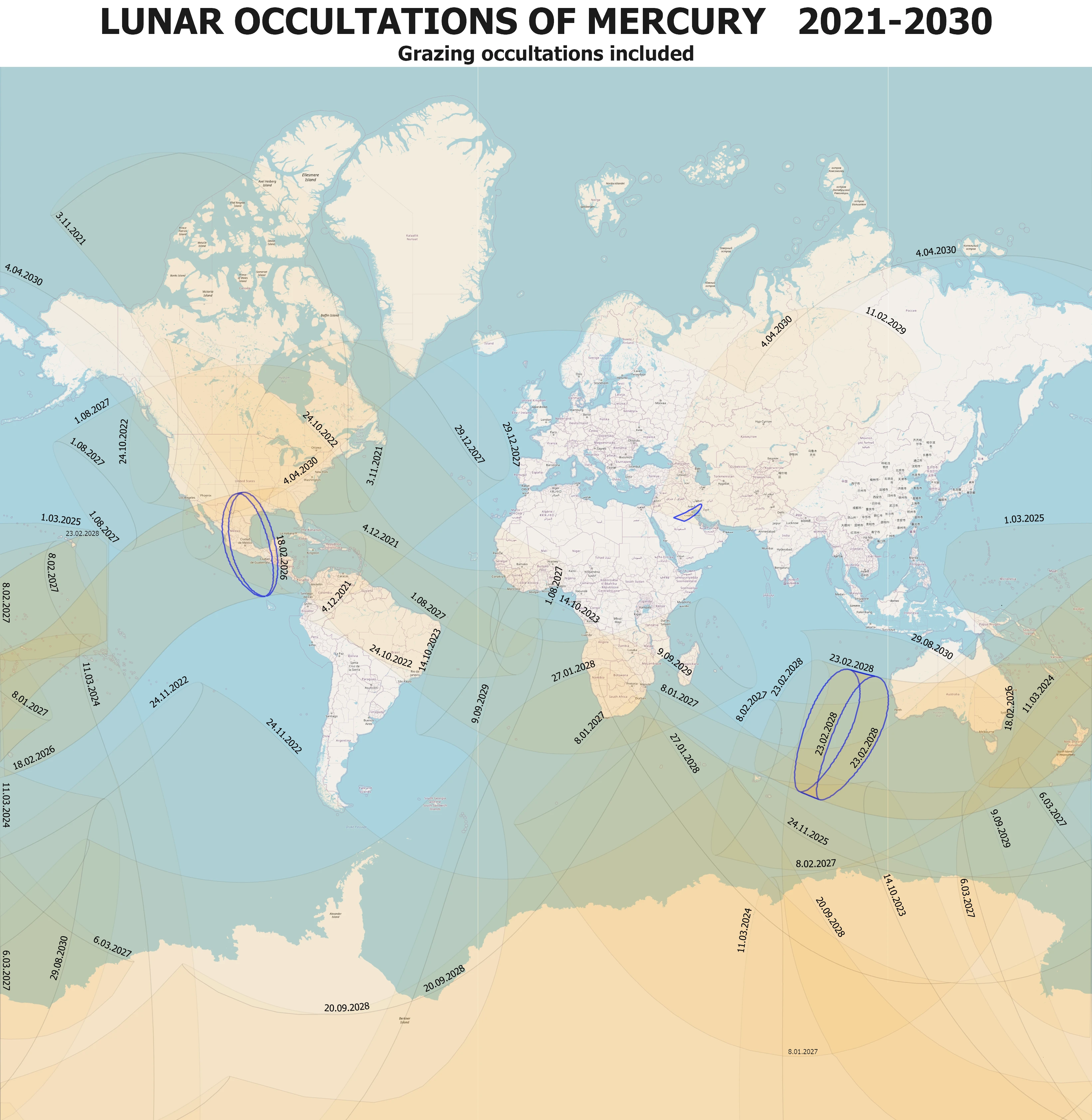
Pic. 27 Lunar occultations of Mercury in the 2021-2030 decade (following Dominic Ford’s calculations made for In-the-sky.org and Eco.mtk.nao.ac.jp occultation maps). Blue lines indicate the area where the occurrence is visible at night or in the twilight. Click to enlarge.

Pic. 28 Lunar occultations of Venus in the 2021-2030 decade (following Dominic Ford’s calculations made for In-the-sky.org and Eco.mtk.nao.ac.jp occultation maps). Blue lines indicate the area where the occurrence is visible at night or in the twilight. Click to enlarge.
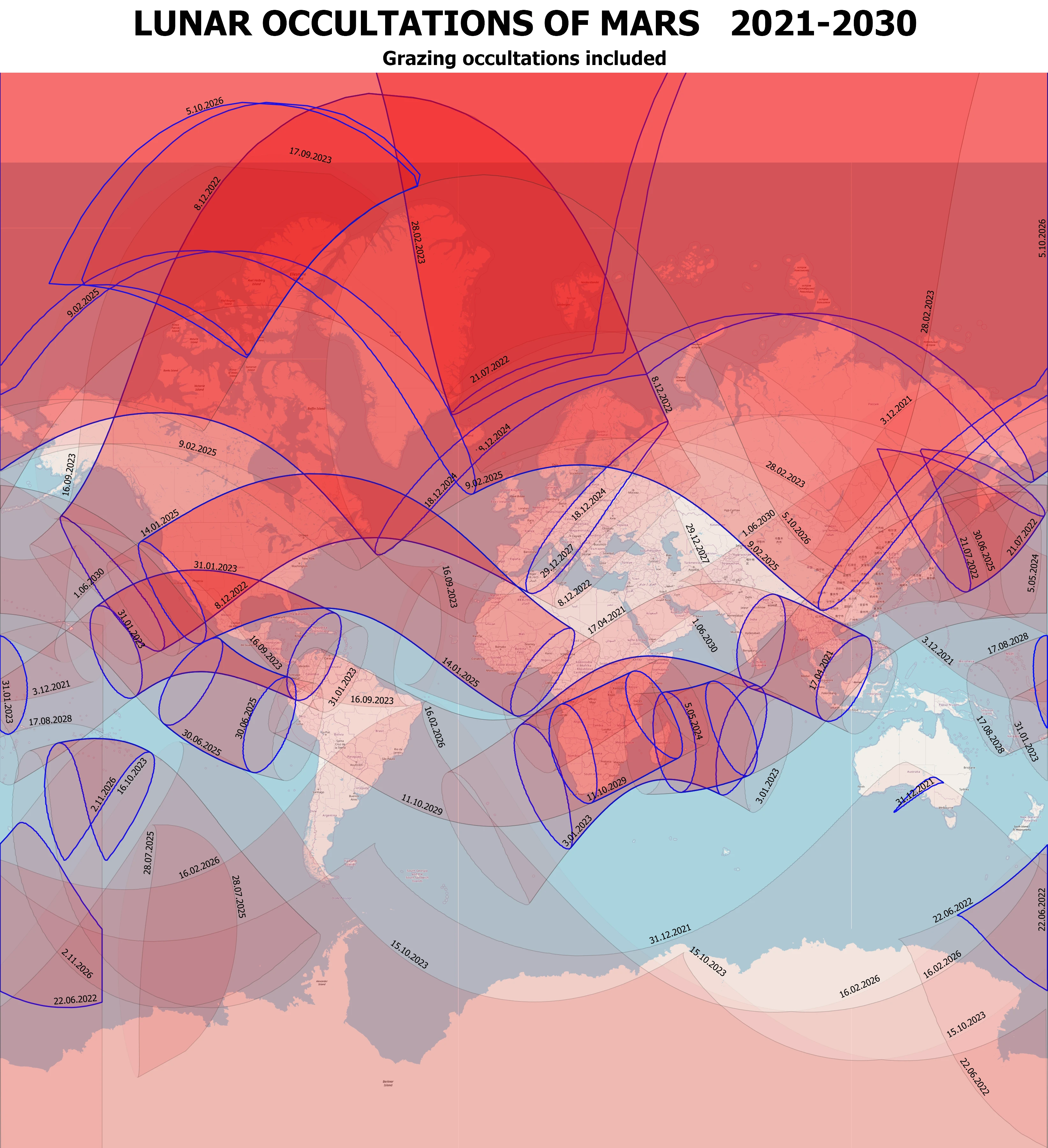
Pic. 29 Lunar occultations of Mars in the 2021-2030 decade (following Dominic Ford’s calculations made for In-the-sky.org and Eco.mtk.nao.ac.jp occultation maps). Blue lines indicate the area where the occurrence is visible at night or in the twilight. Click to enlarge.
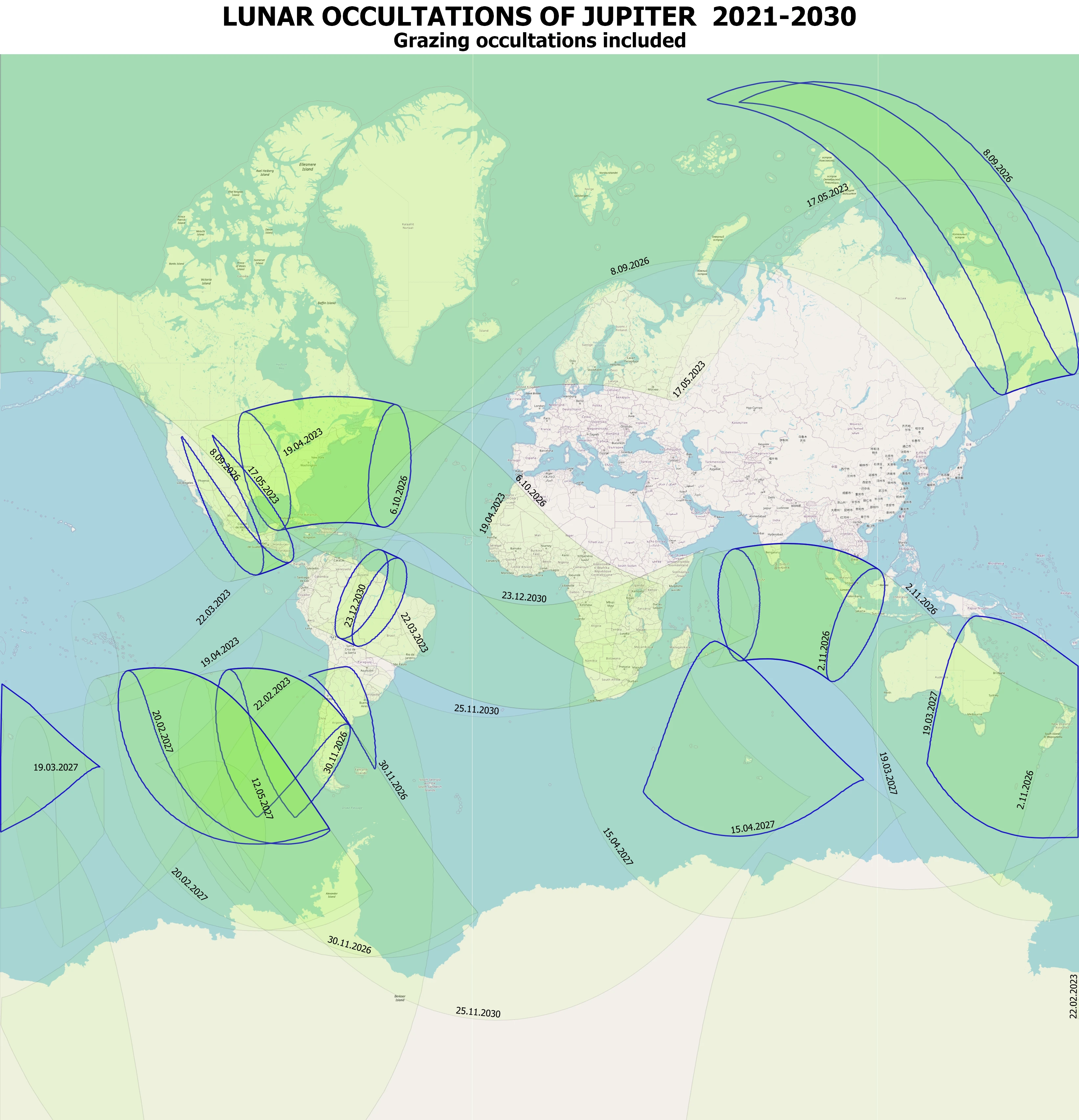
Pic. 30 Lunar occultations of Jupiter in the 2021-2030 decade (following Dominic Ford’s calculations made for In-the-sky.org and Eco.mtk.nao.ac.jp occultation maps). Blue lines indicate the area where the occurrence is visible at night or in the twilight. Click to enlarge.

Pic. 31 Lunar occultations of Jupiter in the 2021-2030 decade (following Dominic Ford’s calculations made for In-the-sky.org and Eco.mtk.nao.ac.jp occultation maps). Blue lines indicate the area where the occurrence is visible at night or in the twilight. Click to enlarge.
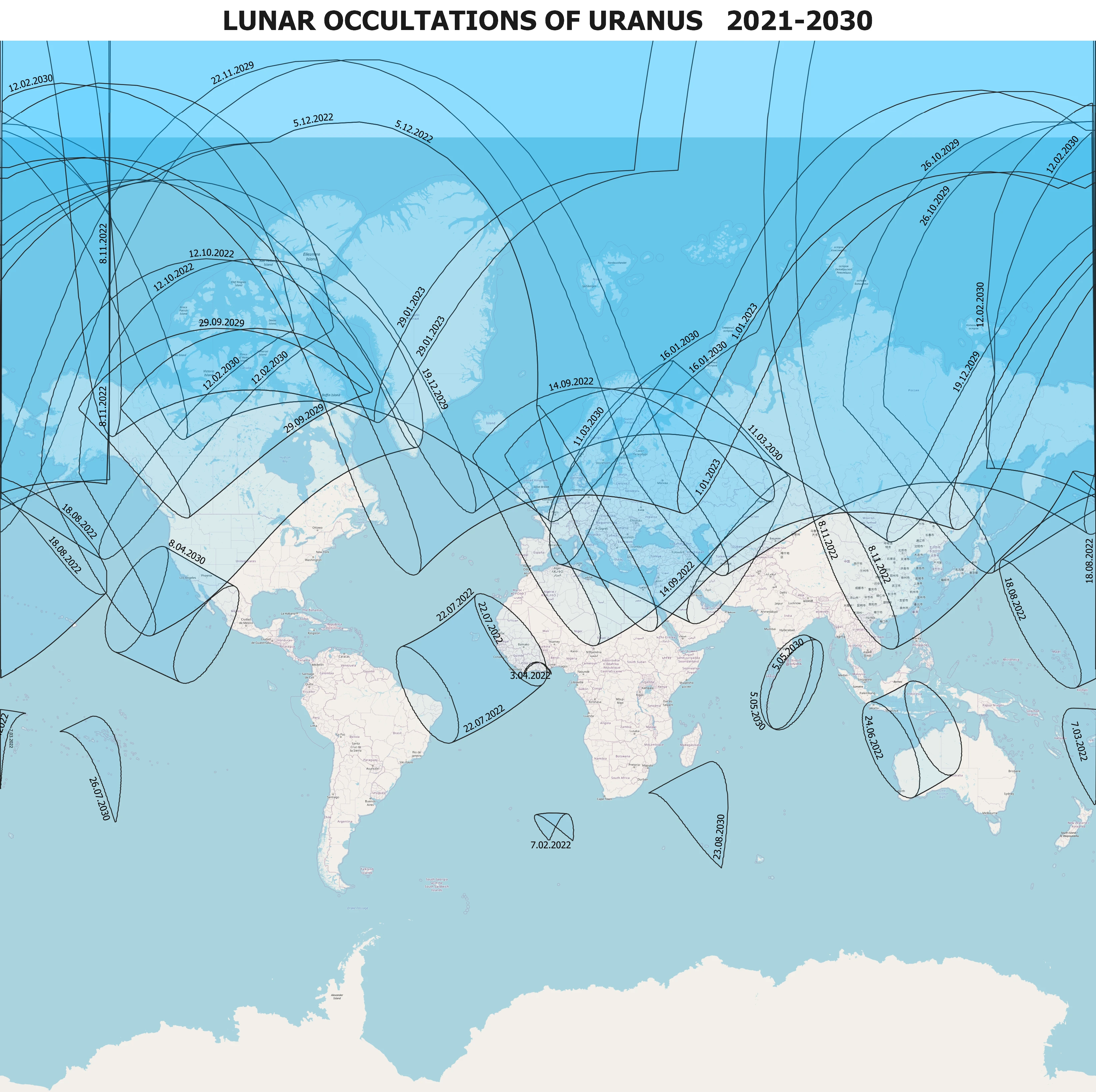
Pic. 32 Lunar occultations of Uranus in the 2021-2030 decade (following Dominic Ford’s calculations made for In-the-sky.org). Only visible events are included. Click to enlarge.

Pic. 33 Lunar occultations of Uranus in the 2021-2030 decade (following Dominic Ford’s calculations made for In-the-sky.org). Only visible events are included. Click to enlarge.
The lunar occultations of Uranus and Neptune are specific also in terms of their frequency. The events occur in series and tend to repeat every month, and are not observed thereafter for a longer time. This is driven by the lunar orbit precession causing gradual changes in the declination range between its southern and northern limits. It has been described here later as the lunar standstill phenomenon. The movement of both Uranus and Neptune in the sky sphere is slow enough to observe this regularity. Uranus needs about 84 years to make the full route around the Sun, the Neptune – 168 years. It means, that both planets don’t change their position in the sky rapidly between single 18,6 years lunar precession period.
5. THE GREAT CONJUNCTION OF VENUS AND NEPTUNE (27.04.2022, 15.02.2023)
Venus and Neptune are not a good combination, because these 2 planets are at very opposite places in terms of their brightness in the sky. The result of their mutual observation might be eye-watering because Neptune will be usually outshined by our neighbor planet. Anyway, it’s good to mention conjunctions such as these, especially when Venus and Neptune almost overlap each other. The “great” conjunctions shown here are the ones in the XXIth century, where the angular separation is lower than 50″ (Pic. 34).

Pic. 34 The chart with all Venus and Neptune conjunctions between AD2000 and AD 2094 (Climate.gi.alaska.edu).
Apparently, the closest approach of Venus and Neptune will occur on April 27, 2022, placing these 2 bodies as close as 6,6″ (Pic. 35).
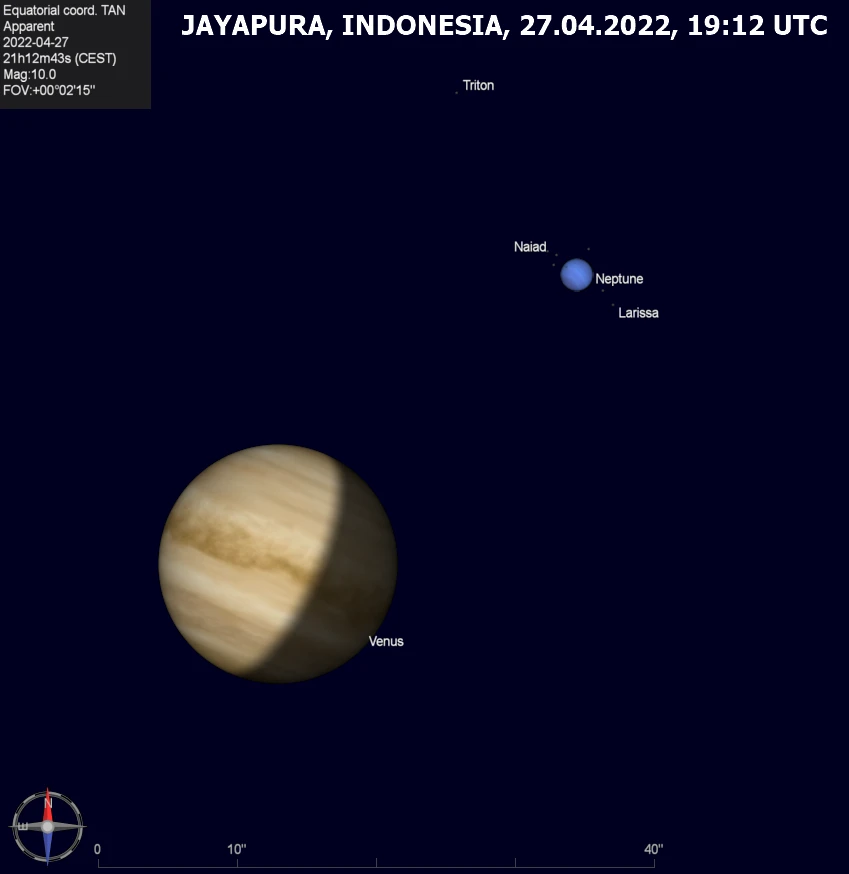
Pic. 35 The closest approach of Venus and Neptune on April 27, 2022 (Cartes du Ciel Sky Charts 4.31).
The observation will be fairly possible because these 2 bodies will be separated about 40 degrees from the Sun. The event will be visible predominantly from Australia and western Oceania (Pic. 37).
Another “great” conjunction will happen just 9,5 months later on February 15, 2023, although this time the separation of these 2 planets will be about 45″. On top of that, the angular distance to the Sun will be twice shorter as previously, so the event won’t be visible under completely dark skies. The twilight glow at astronomical dusk can deteriorate the visibility of Neptune. Furthermore, the phase of Venus also won’t contribute positively to the event (Pic. 36).
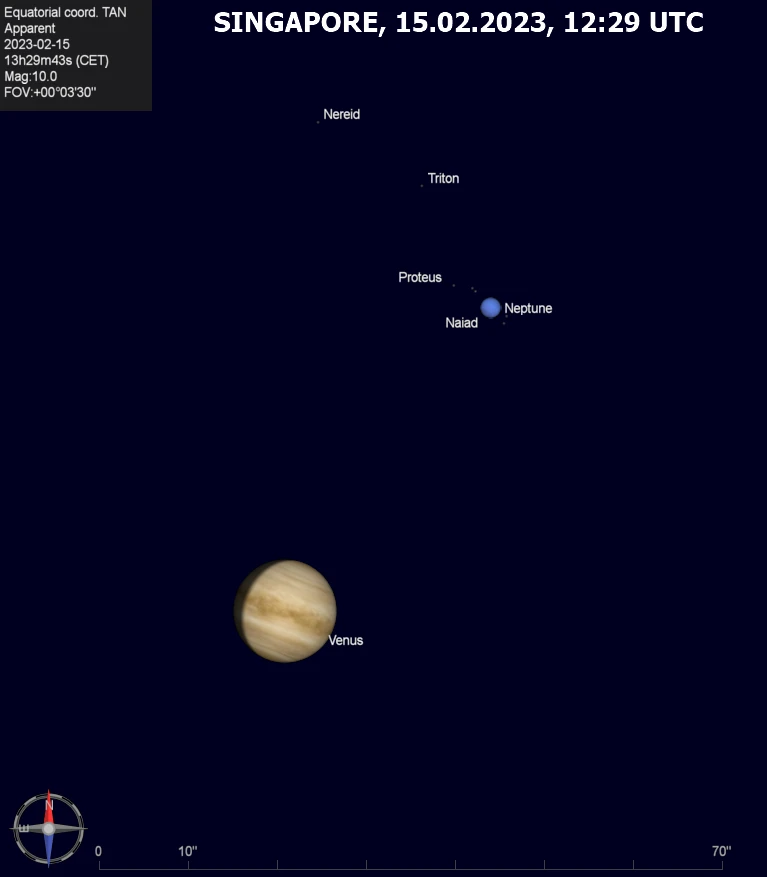
Pic. 36 The “great” conjunction of Venus and Neptune, when the angular separation appears to be the smallest in the XXI century; 35 – 27.04.2022; 36 – 15.02.2023 (Cartes du Ciel Sky Charts 4.31).
The event can be seen in Eastern Asia (Pic. 37).
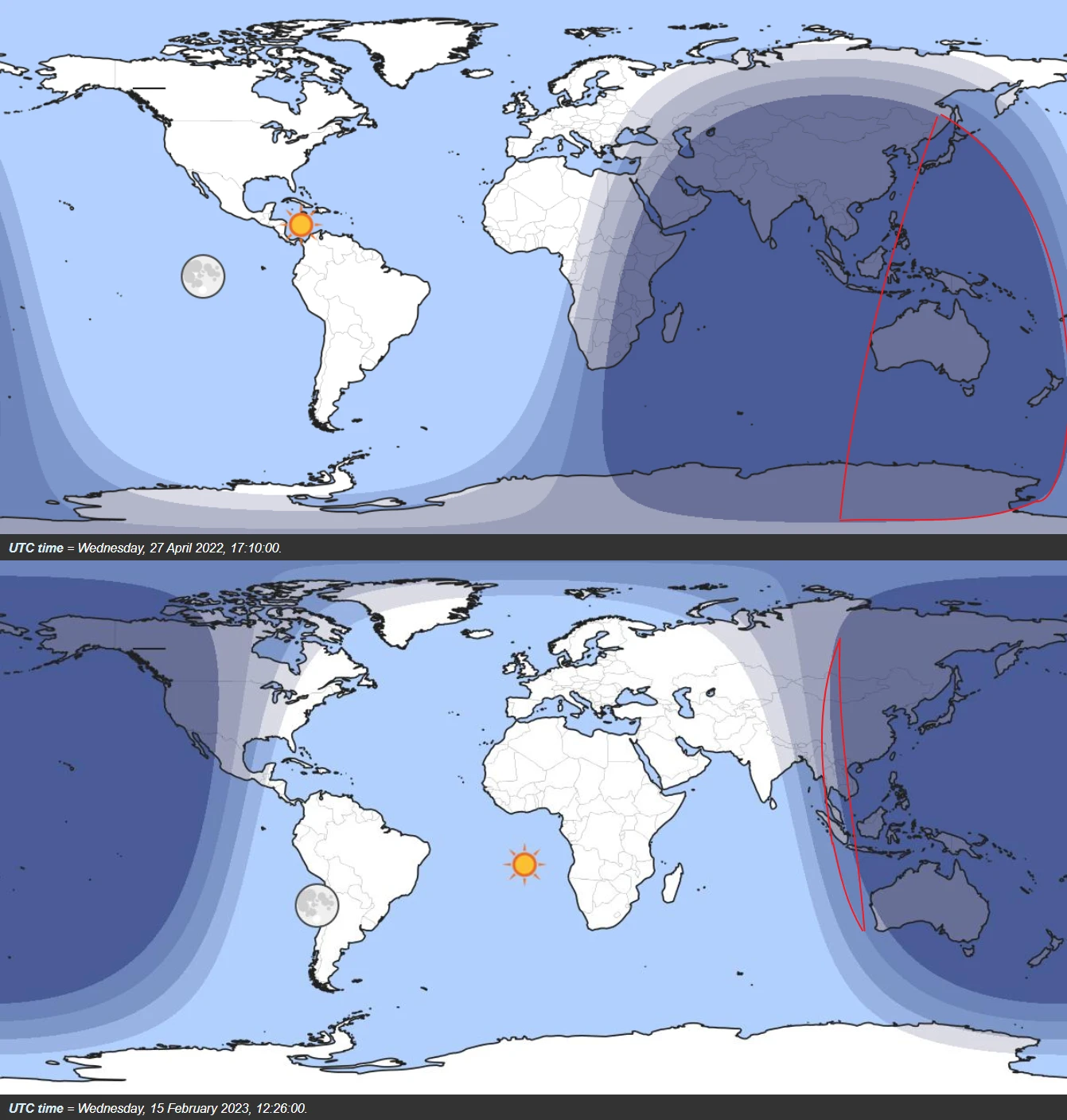
Pic. 37 The “great” conjunction of Venus and Neptune in 2022 and 2023 – the best conditions worldwide (Timeanddate.com).
Another significant conjunction of Venus and Neptune will occur on March 7, 2026, when these 2 bodies will be as close as 0°04′ to each other, and on May 13, 2030 (16,7′ away from each other).
6. THE GREAT CONJUNCTION OF MARS AND NEPTUNE (29.04.2024)
This is also the conjunction, which doesn’t happen so often. We have three intervals of conjunctions: 537-556 days, 700-718 days, and 33-117 days. The most frequent interval is between 700 and 718 days and in the 2021-2030 decade, these 2 planets will meet each other with a frequency such as this. The most spectacular conjunction will take place on April 29, 2024, before sunrise. Both celestial bodies will be as close as 2 arc mins (Pic. 38).
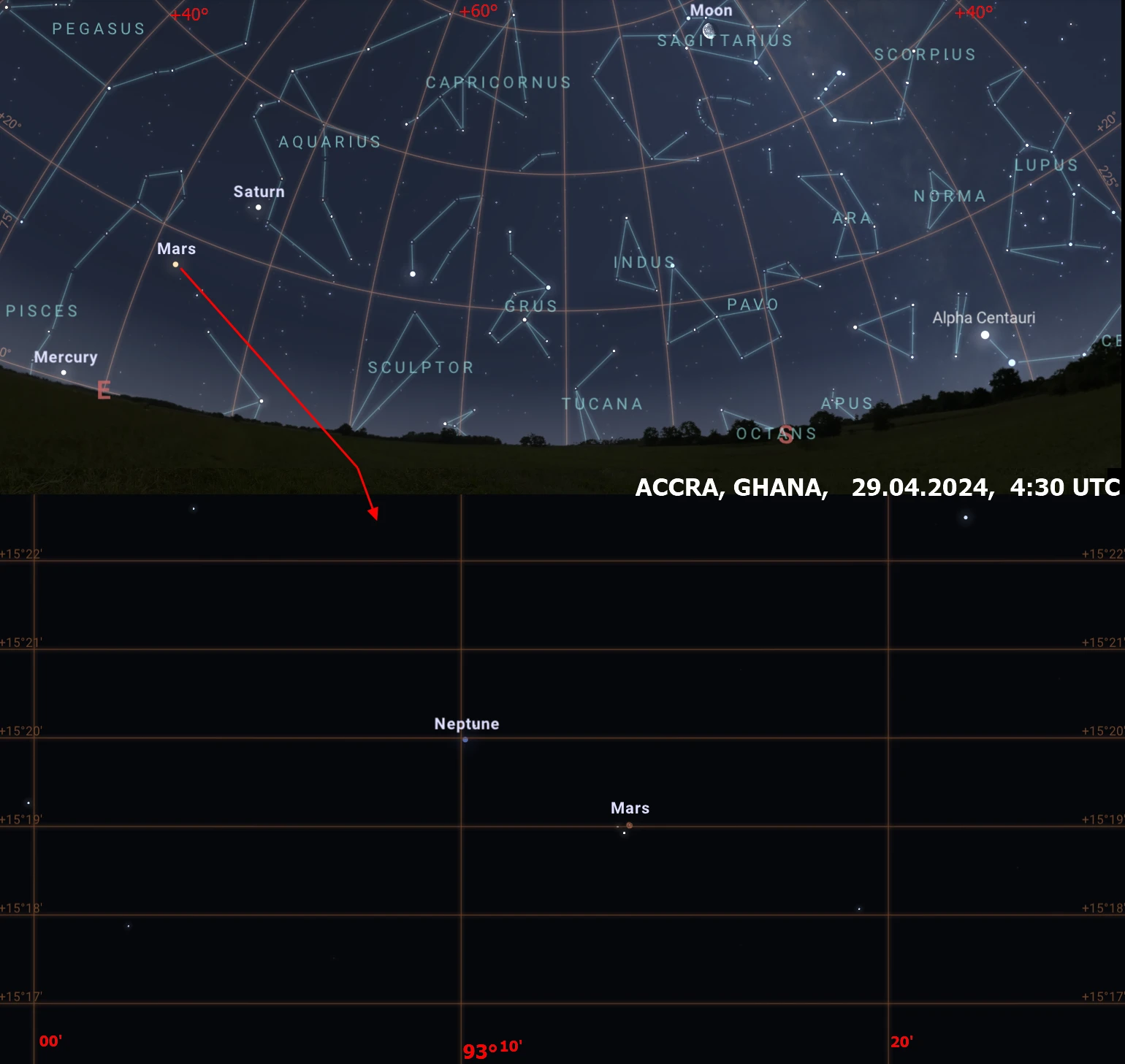
Pic. 38 The great conjunction of Mars and Neptune is possible to see from equatorial locations on April 29, 2024 (Stellarium-web.org).
Unfortunately, the northern hemisphere won’t be fortunate to witness this event, due to the position of these planets on the ecliptic. Far better conditions will occur near the equator and from the southern hemisphere (Pic. 39). The planets are about 34 degrees from the Sun, which restricts the territory of best visibility.

Pic. 39 The “great” conjunction of Mars and Neptune on April 29, 2024 – map of visibility (Timeanddate.com).
7. THE GREAT CONJUNCTION OF MERCURY AND JUPITER (4.06.2024)
There are only 3 times till 2076 when Mercury is closer to Jupiter than 10′ (Pic. 40).
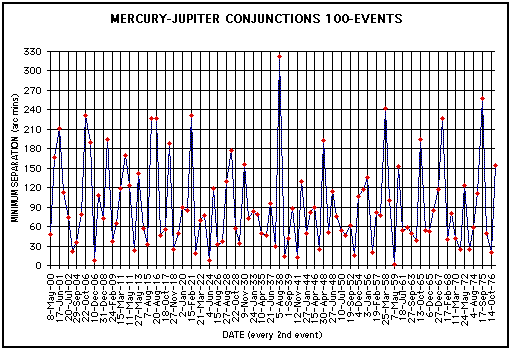
Pic. 40 The conjunction of Mercury and Jupiter between AD2000 and AD2076 (Climate.gi.alaska.edu).
The last “great” conjunction of these 2 bodies occurred in 2006, the next one will fall on June 4, 2024, and it will be the last one before the big meeting in 2059.
Regrettably, the closest approach will be visible in a narrow swath in the western hemisphere, mostly south of the equator. The angular distance of these 2 planets from the Sun is only 12°, so imagine how the observation window can be small. The planets rise when the nautical twilight begins. Because of their brightness (Jupiter -1.84 Mag and Mercury -1.07 Mag), an observer can easily track these planets at least upon the beginning of the civil dawn. The angular separation between them is only 0°02′, so it will be enough to spot Jupiter low above the horizon. There is rather no chance to see the Pleiades, accompanying Jupiter and Mercury a bit towards the north. Quite a good indicator can be the crescent Moon, rising about one hour before the planets, which is about 15 degrees away from them (Pic. 41).
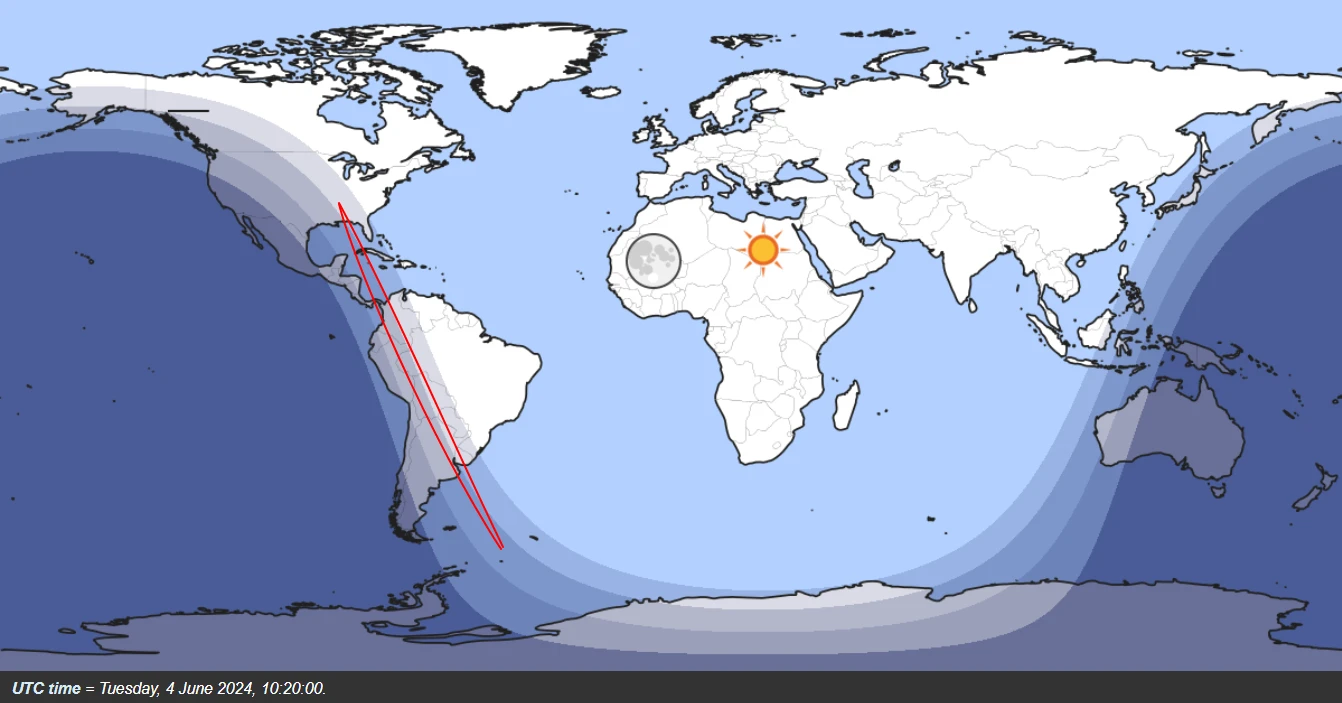
Pic. 42 The Mercury and Jupiter conjunction on June 4, 2024 – the best visibility map (Timeanddate.com).
8. UNUSUAL CIRCUMSTANCES OF JUPITER’S GALILEAN SATELLITES
There are some events reserved only for people, who own at least good binoculars. The Galilean satellites act somewhat as the minor Solar System. They can transit across Jupiter’s disk, hide behind it, or occult each other. These four giants orbit Jupiter with almost perfect resonance, which means, that they can’t eclipse, occult, or be elongated all at the same time. However, these situations cannot be excluded completely. Every 12 years on average, the Galilean giants seem to disappear completely because of transit across Jupiter’s disk or occultation by the biggest planet in our Solar System. The last event such as occurred in 2009 and the next one is happening in 2021. Furthermore, Jupiter will be almost the closest to Earth, because it reaches opposition on August 19, whereas the event takes place on August 15. The disappearance of Galilean satellites won’t last long. It will take about 3 minutes between the eclipse of Io by Jovian shadow and the IIIrd contact of Callisto with the Jovian disk (Pic. 43, 44).

Pic. 43, 44 – The local circumstances for Hyderabad (43) where the Galilean Satellites disappearance event can be observed (44) in the span of 10 minutes in total (Stellarium-web.org/ Cartes du Ciel Sky Charts 4.21). Click to enlarge.
The event will be seen everywhere beyond the terminator line, as the planet is located nearly on the opposite side of the sky to the Sun (Pic. 45).

Pic. 45 The Day & Night map for August 15, 2021, at 15:42 UTC – the greatest moment of Galilean Satellites’ disappearance (Timeanddate.com).
Other spectacular events related to Galilean Satellites are their extreme elongations, which can reach 14-15′ (Pic. 46). We have 3 events such as this across the current decade.
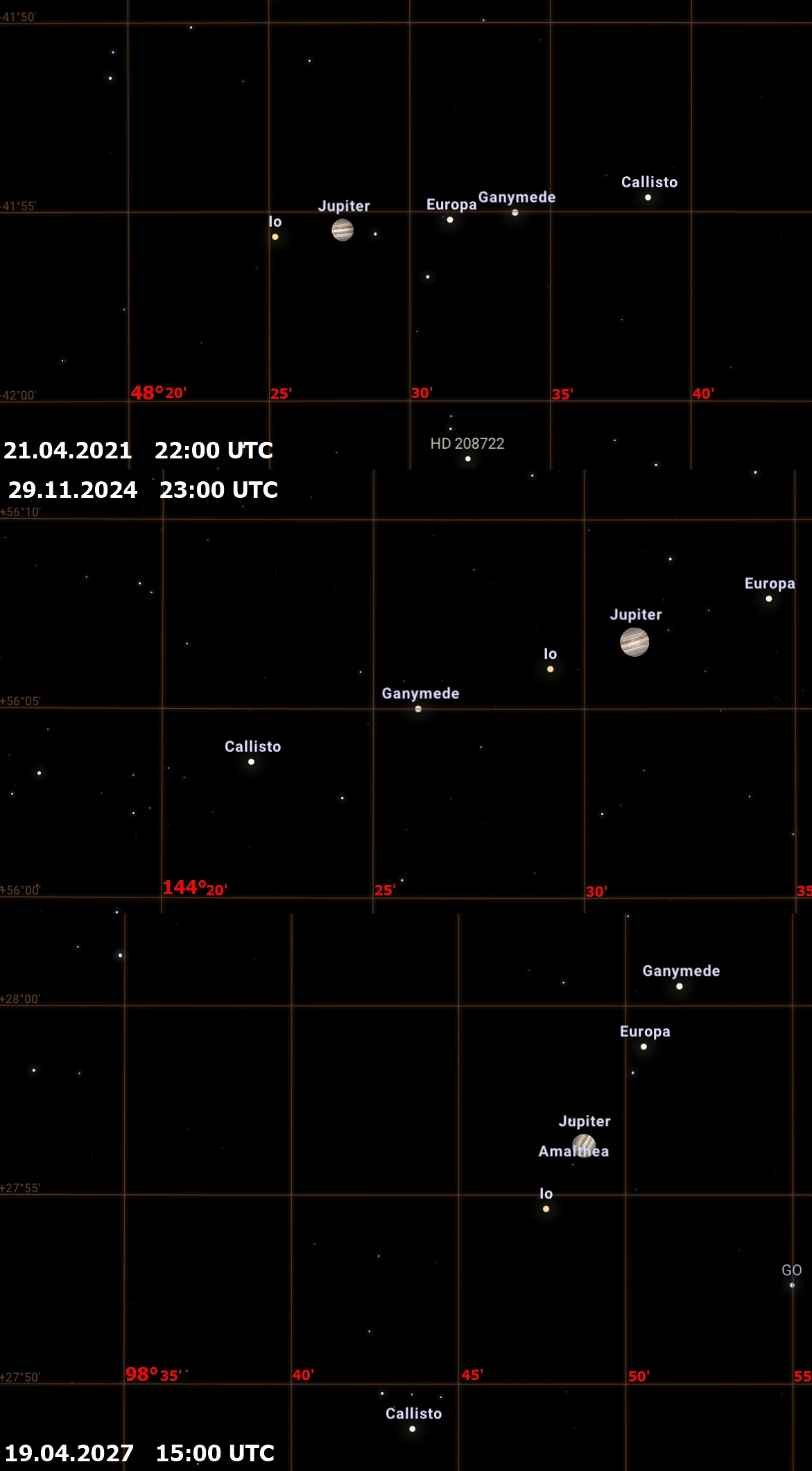
Pic. 46 The extreme elongations of the Galilean satellites, study case for Cambridge, UK (Stellarium-web.org).
9. HALLEY-TYPE COMETS (THE BRIGHTEST IN APRIL 2024)
In the 2021-2030 decade, we should expect at least a few periodic comets. None of them will be visible to the naked eye, but possible to see through binoculars. Periodic comet returns near the Sun every 200 years or less. Some of them appearing once in a lifetime belong to Halley-type comets. There are several Halley-type comets, which will travel close to the Sun in this decade, but as mentioned earlier none of them will be visible to the naked eye. The brightest will have 5 Mag near its perihelion, so it will be at the edge of human sight. Anyhow, this comet can be quite spectacular, at least it was in 1954 when it was recently seen (Pic. 47).

Pic. 47 Sketches of Comet 12P/Pons-Brooks made in 1954 when it was recently seen (George Alcock/Rocketstem.org).
The 12P/Pons-Brooks comet was discovered in 1812 when reached a brightness of approximately 4 Mag for about 2 months. The orbital period of this comet is about 70-71 years. In April 2024 the comet will move between Arias and Taurus constellations (Pic. 48).

Pic. 48 The 12P/Pons–Brooks comet path across the sky in 2024 (Rocketstem.org).
Other quite bright Halley-type comets traveling near the Sun between 2021 and 2030 are:
– P2005/W3 Kowalski (November, 2021) – 8,5 Mag
– P2002/T6 (August, 2024) – 6 Mag
– P2004 DO29 (March, 2025) – 10 Mag
– P2005/S2 (December, 2028) – 7,8 Mag
– P2005/T3 (August, 2026) – 9,2 Mag
– P2007/C2 Catalina (April, 2026) – 10 Mag
and more are listed here.
10. SATURN WITHOUT RINGS
Saturn’s axial tilt is 26,7 degrees, which means that the view of its rings varies widely. About every half of Saturn’s year Earth passes through the ring plane (13-15 years).
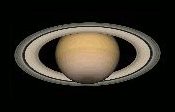
Pic. 49 Saturn’s axial tilt and rings behavior over the course of one Saturn’s year as seen from Earth (Wikimedia.org).
On such occasions, the Saturn ring plane crossing may occur between 1 and 3 times. The last event such as this occurred on September 4, 2009, the next upcoming will occur on March 23, 2025, and afterward, in 2039 triple plane crossings will take place. At a similar time, however not evenly spaced (due to Earth’s orbit inclination) Saturn’s equinoxes take place. Equinoxes on Saturn mean, that the Sun passes the ring plane. At this moment the illumination of rings is significantly reduced, giving the opportunity for unique observations of the features, that depart from the ring plane. On May 9, 2025, the autumn equinox will occur on Saturn. The vernal equinox occurred on August 11, 2009, and will occur again on January 23, 2039.

Pic. 50 The oppositions of Saturn in the 2001-2029 period correspond to the axial tilt of the planet against Earth (Instagram.com/Astronomhub).
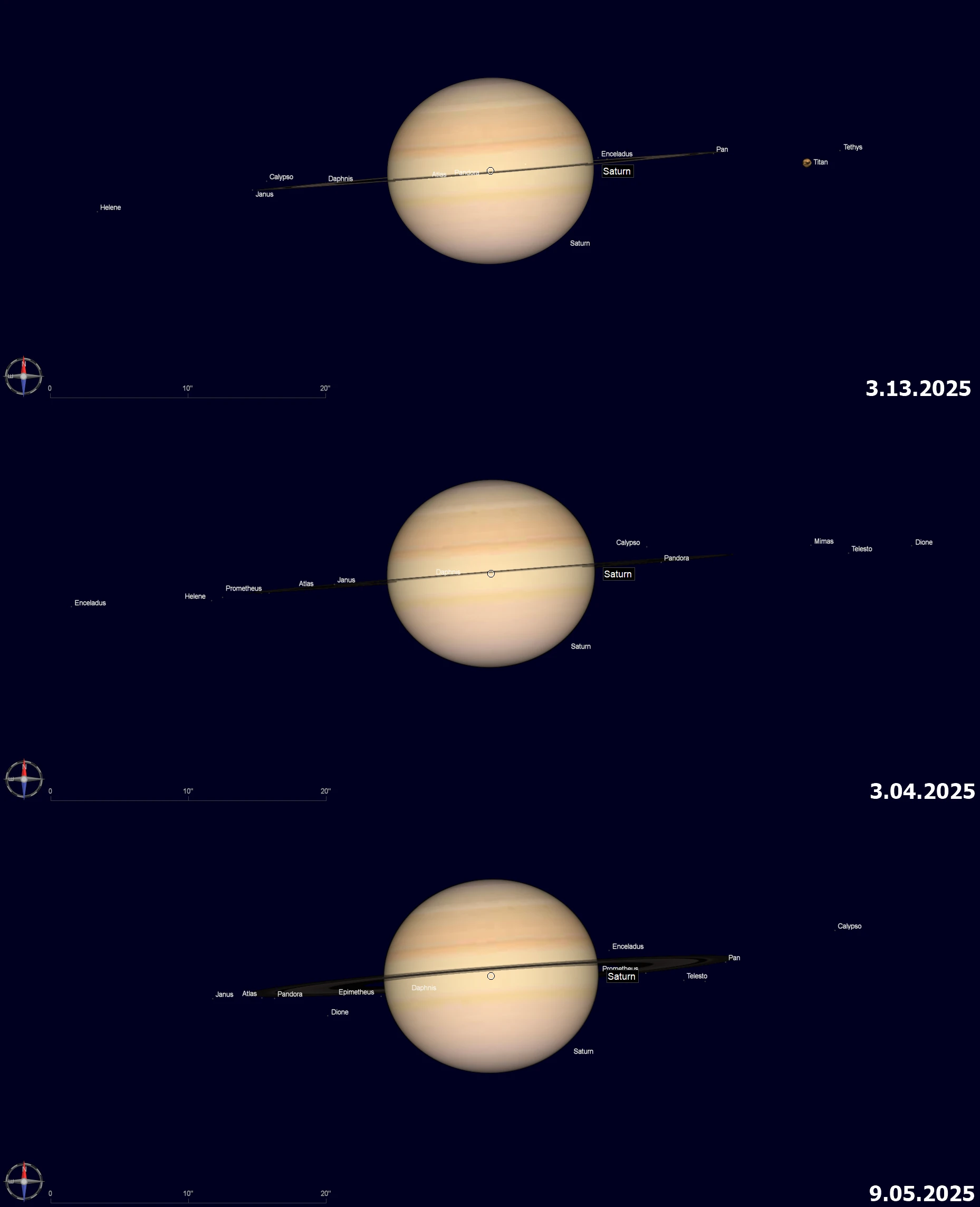
Pic. 51 Saturn ring plane crossing in 2025 – dates around the moment falling on March 23 and the day of Saturnian autumn equinox on May 9 (Cartes du Ciel Sky Chats 4.21).
11. EXTREMELY HIGH & LOW ALTITUDE OF THE MOON (MAJOR LUNAR STANDSTILL)
The lunar orbit is inclined by 5.14° to the ecliptic, which means, that the Moon can be higher or lower from the Earth’s plane orbit by this value. The Earth’s spin axis is also tilted with respect to the Earth’s orbital plane and fixed in space. The result, which we observe is the seemingly sinusoidal path of the Sun on the celestial sphere against the horizontal celestial equator. Considering the behavior of the sinusoid in general, we can see the moments where the considered changes progress so quickly, whereas next these changes slow down upon reaching the minimum or maximum value. The same applies to the solar track across the celestial sphere. Near equinoxes, the altitude of the Sun against the horizontal celestial equator (solar declination) changes quickly, and further slows down, reaching its peak or lowest point at solstices, which has been perfectly depicted below (Pic. 52).

Pic. 52 Solar path over the year (ecliptic plane, green) against the horizontal celestial equator (red)(Community.durac.uk).
Looking at the animation above, you can see, that the Sun crosses the horizontal celestial equator twice: at the vernal equinox, when goes upwards, and autumn equinox, when goes downwards. This is the true effect of the Earth’s spin axis inclination and it’s marked on the celestial sphere as the ecliptic line. The lunar orbit inclination against the ecliptic works on exactly the same basis. We have the “places” where this apparent orbit crosses the ecliptic line, and they are called nodes (lunar nodes). In one node, the Moon’s path crosses the plane of Earth’s orbit towards the north, occupying the northern ecliptic hemisphere (ascending node), and in the other one, towards the south, the southern ecliptic hemisphere (descending node).
It’s still not as simple, as you can think, because of the lunar nodal precession, which encloses within around 18.6 years. This is the period called the draconic or nodal period, where these lunar nodes move along the ecliptic line westward in relation to the vernal equinox. When both nodes are in the right “place” (ascending node at 0h), then we can experience the lunar declination extremes. Explaining roughly, the ascending node must coincide with the vernal equinox (the autumn equinox in the southern hemisphere) when the Sun enters the northern ecliptic hemisphere. In this case, the inclination of the lunar orbit will be “added” to the solar declination, making the lunar declination extreme. This moment is the major lunar standstill when the Moon reaches further north and further south than the Sun. In turn, we can see our satellite extremely high and extremely low in the sky within just 2 weeks. Along with it, the moonrise and moonset azimuths are also further north and south. By contrast, when the ascending node is located at the autumn equinox (the vernal equinox in the Southern hemisphere) we have the opposite situation because the inclination of the lunar orbit is “deducted” from the solar declination. As a result, the maximum lunar declination is reduced by the lunar orbit inclination against the maximum solar declination (Pic. 53).
The nodal precession moves around the ecliptic, making the final circle within 18,6 years. Their position throughout this time mark somewhat moments of the eclipses, as both lunar and solar eclipse, requires the perfect alignment of Earth and Moon against the Sun. An alignment such as this can only occur around the nodes. For major lunar standstill, the eclipse season near the March equinox refers to solar and lunar eclipses at an odd-numbered saros, whereas another eclipse season near the September equinox has solar and lunar eclipses at even-numbered saros. For a minor lunar standstill, it’s exactly upside down. Back to the explanation of the ecliptic behavior, we have the same with lunar node precession. The major lunar standstill is admittedly the moment, but its aftermath can be observed around 2-3 years earlier and later, due to sinusoid behavior. The same as the summer solstice doesn’t mean, that the next forthcoming day will be significantly shorter. The lunar standstill will be considered again as a separate topic and I want to explain it much wider.
For the purpose of this article, we should be aware of a major lunar standstill occurrence in March 2025. As it has been told the outcome of the major lunar standstill is visible much longer than the moment itself, I want to point out, especially the full Moon, which will be at the highest and lowest position ever observed.
December 15, 2024, will be the date of the full Moon occurrence, which is called the “Cold Moon” because of the winter and cold air masses approach. The lunar declination will be as high as +28.43, which means, that the Moon can pass Zenith even at Tenerife. On the other hand, all latitudes beyond 61 north will see the Moon above the horizon for the entire day.

Pic. 54 The major lunar standstill example for Stockholm (59°N), when the lowest Moon peak is just 1° above the horizon and the highest as high as 59° above the horizon a half year earlier, and visible for almost 24 hours. The lunar declination changes dynamically, hence the moonrise/moonset azimuths are never symmetrical to the lunar “noon”. Only full Moon dates are considered here (Stellarium 0.20.3).
An opposite situation will occur on June 11, 2025, when the Full Moon will reach the declination -28,39. In case such this, all latitudes north of about 61 degrees won’t see the Moon at all. In other locations in the northern hemisphere, the Moon will peak extremely low above the horizon. The full Moon on June 11, 2025, is called a Strawberry Moon, because of the ripening strawberries at this time of the year.
For the southern hemisphere, the situation will be exactly the opposite.
We also should take into account the Moon at the other phases, when it’s the highest and lowest in the sky. The moment of major lunar standstill falls on March 2025, when the Moon will reach the declination accordingly of +28,71 on March 9 and -28,72 on March 22, which correspond accordingly to the Ist and IIIrd quarters of the Moon.
The extreme declinations of the Moon mean changes in the moonrise and moonset azimuth, as also mentioned above. During this period, the Moon rises and sets more northward and southward against the Sun (Pic. 55).
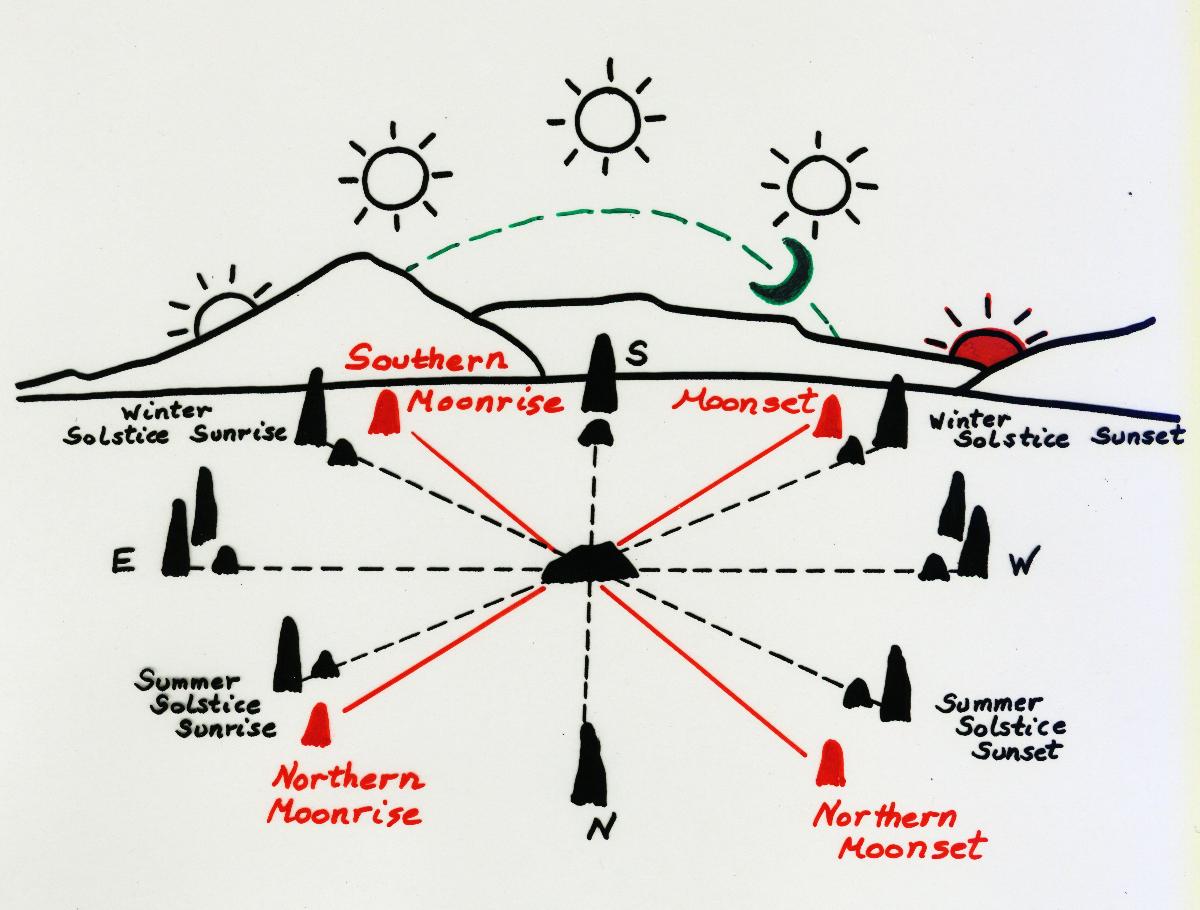
Pic. 55 The major lunar standstill moonrise and moonset azimuths against the extreme sunrise and sunset azimuths (Umass.edu).
Threading its way, we have a rare occasion to see how the Moon rises or sets above some distant landscape features from the given location (Pic. 56).
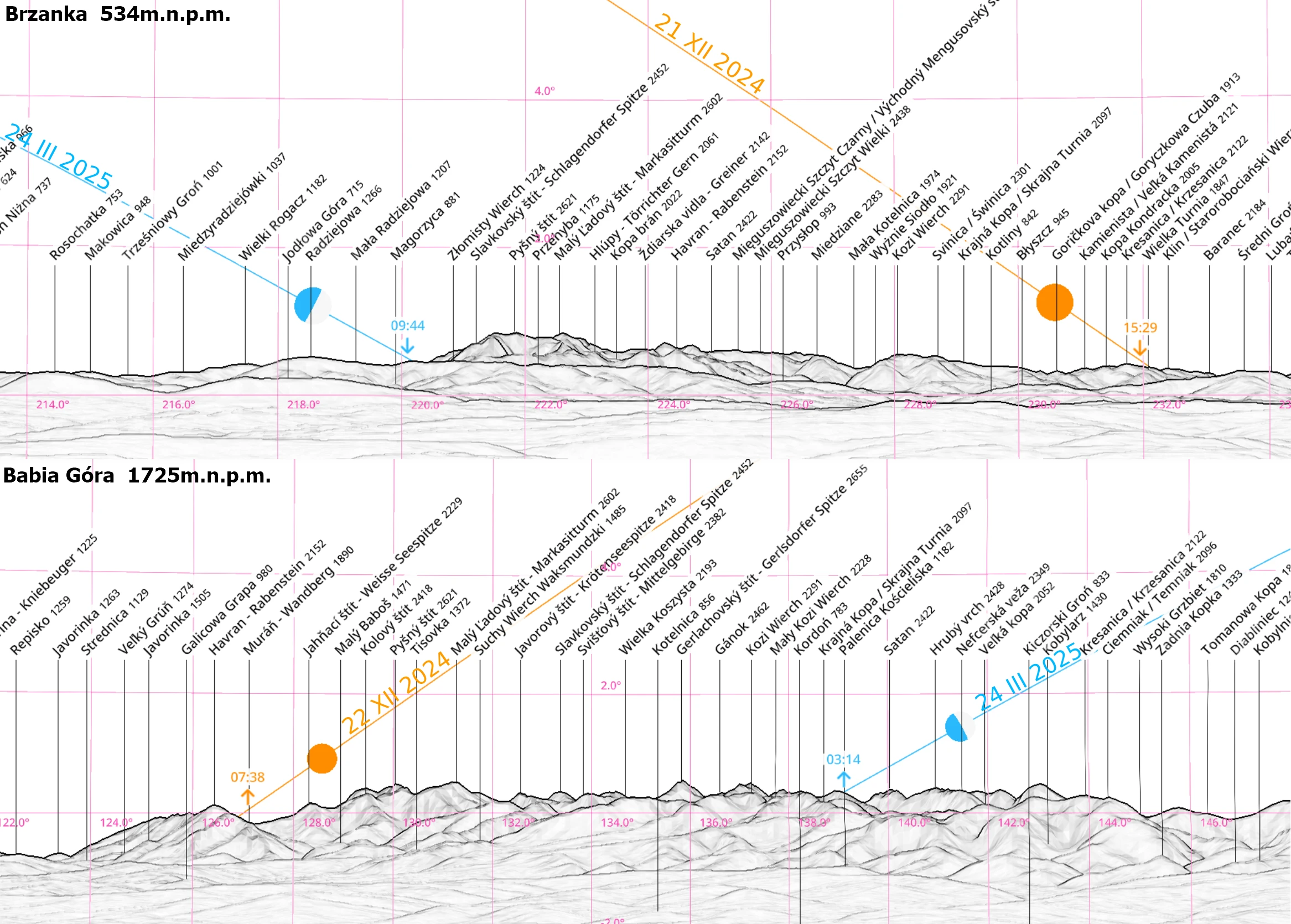
Pic. 56 The major lunar standstill 2025 with respect to the moonrise/moonset at the southernmost azimuth in southern Poland (rise or set above Tatra Mts possible to see from Beskidy Mts)(Peakfinder.org).
As the moonrise/moonset azimuth is closer to the E/W cardinal points, the occasion for chasing the Moon on this basis happens more often (Pic. 57).
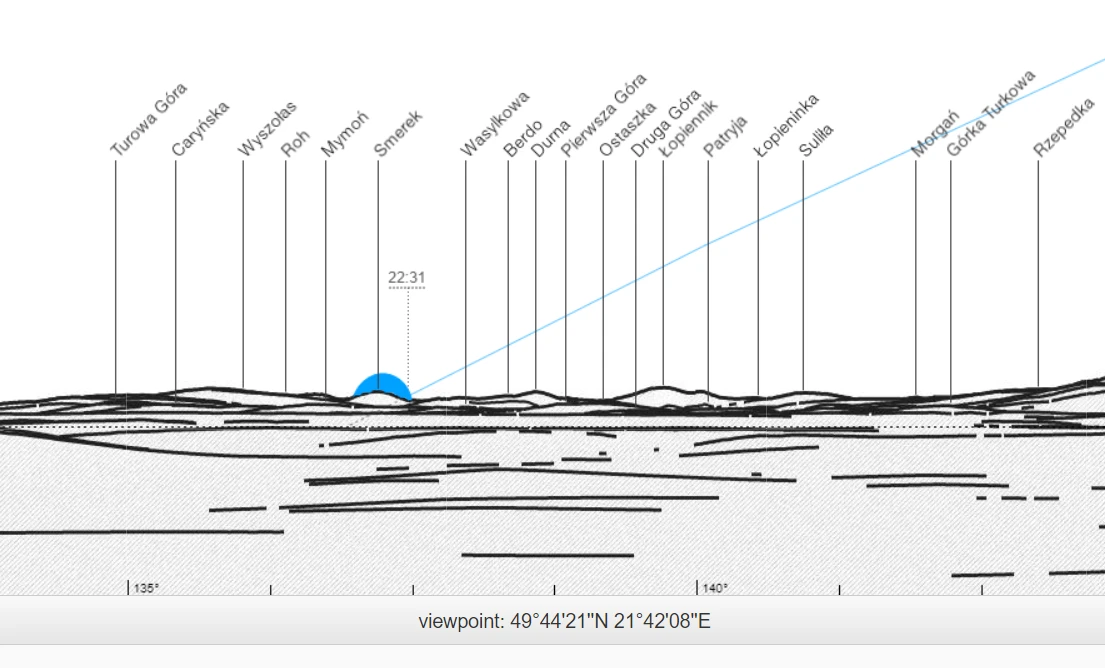
Pic. 57 One of the extremely south azimuth for moonrise in Ustrobna village (Poland), which can occur above the Bieszczady mountains – June 12, 2025, amidst other several situations such as this in 2024 and 2025 (Peakfinder.org).
12. THE TRIPLE CONJUNCTION OF SATURN AND NEPTUNE (2025-2026)
The triple conjunction in astronomy is an event, in which two planets or a planet and a star meet each other in a short period of time. It usually happens around opposition or inferior conjunction, when the internal planet is involved. From an observer’s point of view the planets in the sky usually prograde at the first conjunction, then retrograde at the second conjunction, and prograde again at the third conjunction. There is one conjunction like this, which will happen in 2025-2026 and applies to Saturn and Neptune in the Pisces constellation (Pic. 58).

Pic. 58 The triple conjunction of Saturn and Neptune in 2025 and 2026 (Stellarium-web.org). Click to enlarge.
Both planets will “defilade” near the stars HD6 and HD27 for about 9 months (Pic. 59).
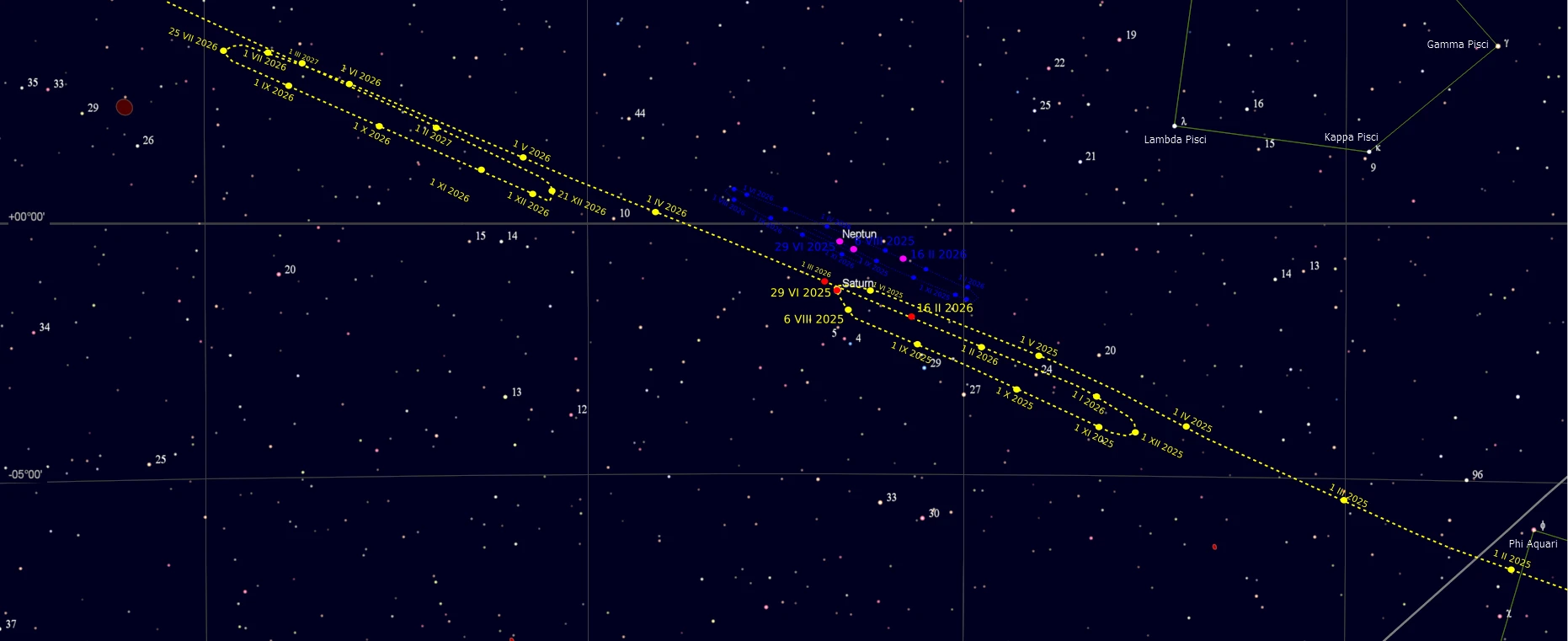
Pic. 59 The triple conjunction of Saturn and Neptun in 2025 and 2026. All the conjunctions are displayed in comparison to the nearest period of the way of both planets across the sky between 1.01.2025 and 1.03.2027 (Cartes du Ciel Sky Charts 4.21).
13. GREAT CONJUNCTION OF MARS AND URANUS (4.07.2026)
The conjunctions of these 2 bodies are predominantly in 549-578-day and 693-725-day intervals. The minimum separations occur in the span of about 13-27 years. The last one observed was in 2013, the next one will occur in 2026, and further in 2053 (Pic. 60).
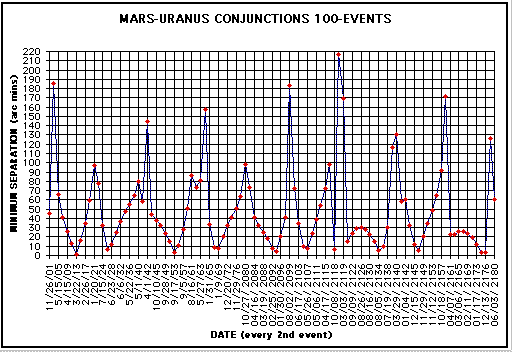
Pic. 60 The conjunctions of Mars and Uranus in the span of 180 years between AD2000 and AD2180 (Climate.gi.alaska.edu).
On July 4, 2026, Mars will be as close as 4′ to Uranus (Pic. 61). However, its angular distance from the Sun, just 35° will restrict the area of good visibility worldwide (Pic. 62).
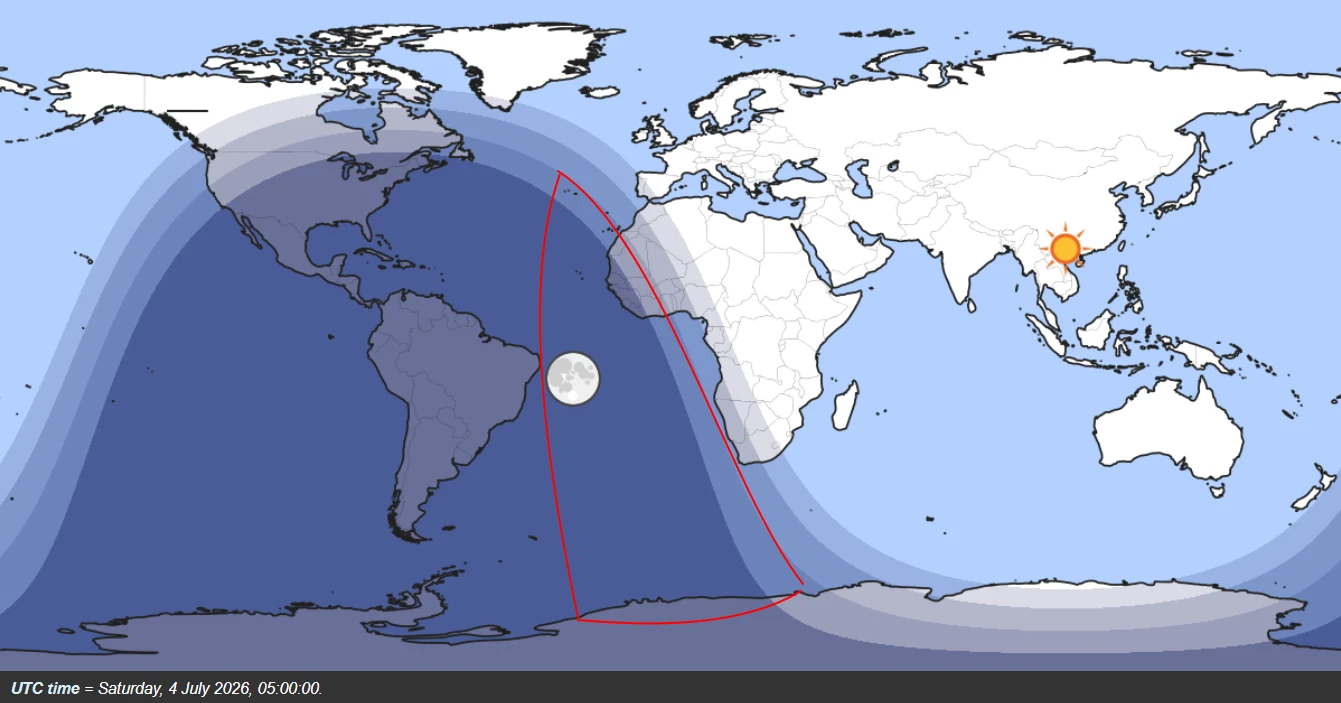
Pic. 61, 62 The “great” conjunction of Mars and Uranus on July 4 2026 considered from the Tenerife (61) and its visibility worldwide (Stellarium-web.org/Timeanddate.com).
14. GREAT INFERIOR CONJUNCTION OF MERCURY (4.11.2026, 12.05.2029)
There is no transit of Mercury across the solar disk observed in the current decade. However, there are 2 moments, in which we would be potentially interested. If you read my article about the inferior conjunction of Venus occurrence in June 2020, then you know that one of the primary goals was chasing our closest neighbor planet within solar prominences when possible. Nobody was successful, furthermore, the closest approach of Venus to the solar limb was expected to be 11’50”, which would need prominence longer than 500000 km. In the case of Mercury in both inferior conjunctions expected in 2026 and 2029, these approaches will be more than twice closer, which seems to be absolutely great. Since the closest passage of Mercury to the solar limb is expected to be about 5,5 – 6,2′ (Pic. 63), we need the prominence as high as “just” 250000-300000km, which is more likely to happen! The biggest downside is the size of Mercury. The first planet in the Solar System can’t be detected by the human eye without any enlargement. The H-alpha filters should include also a decent optical zoom in order to make this observation successful.
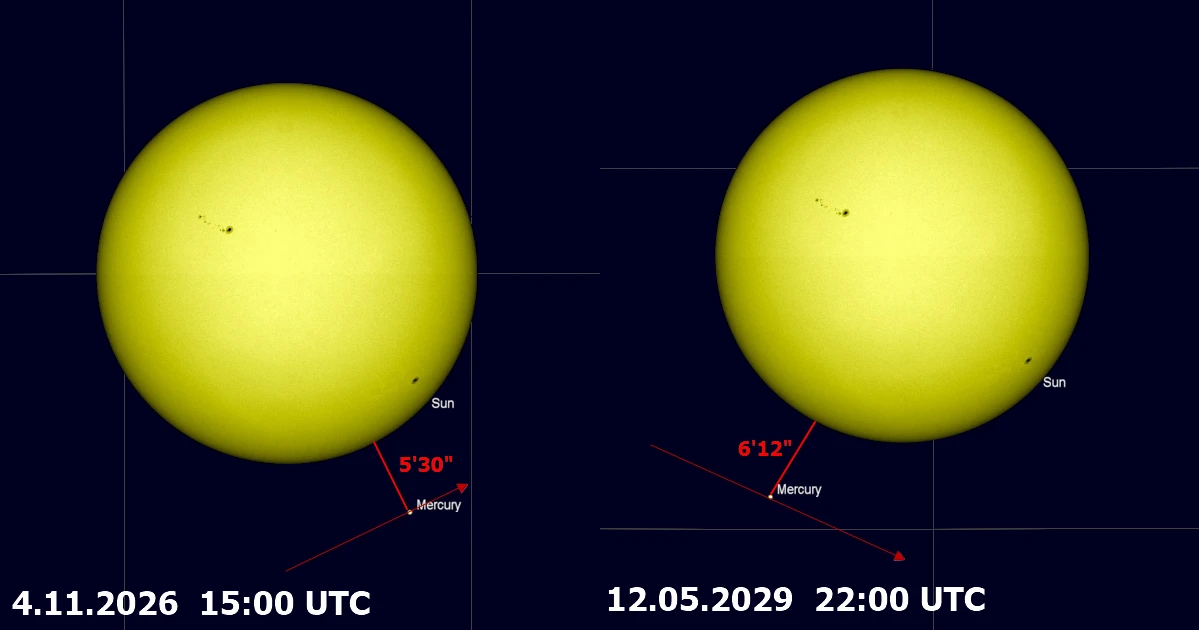
Pic. 63 The inferior conjunction of Mercury in 2026 and 2029 with the possibility of seeing the planet with solar prominences in the background if the H-alpha filter is used. The arrow shows the movement of the planet in the sky against the Sun (Cartes du Ciel Sky Charts 4.21).
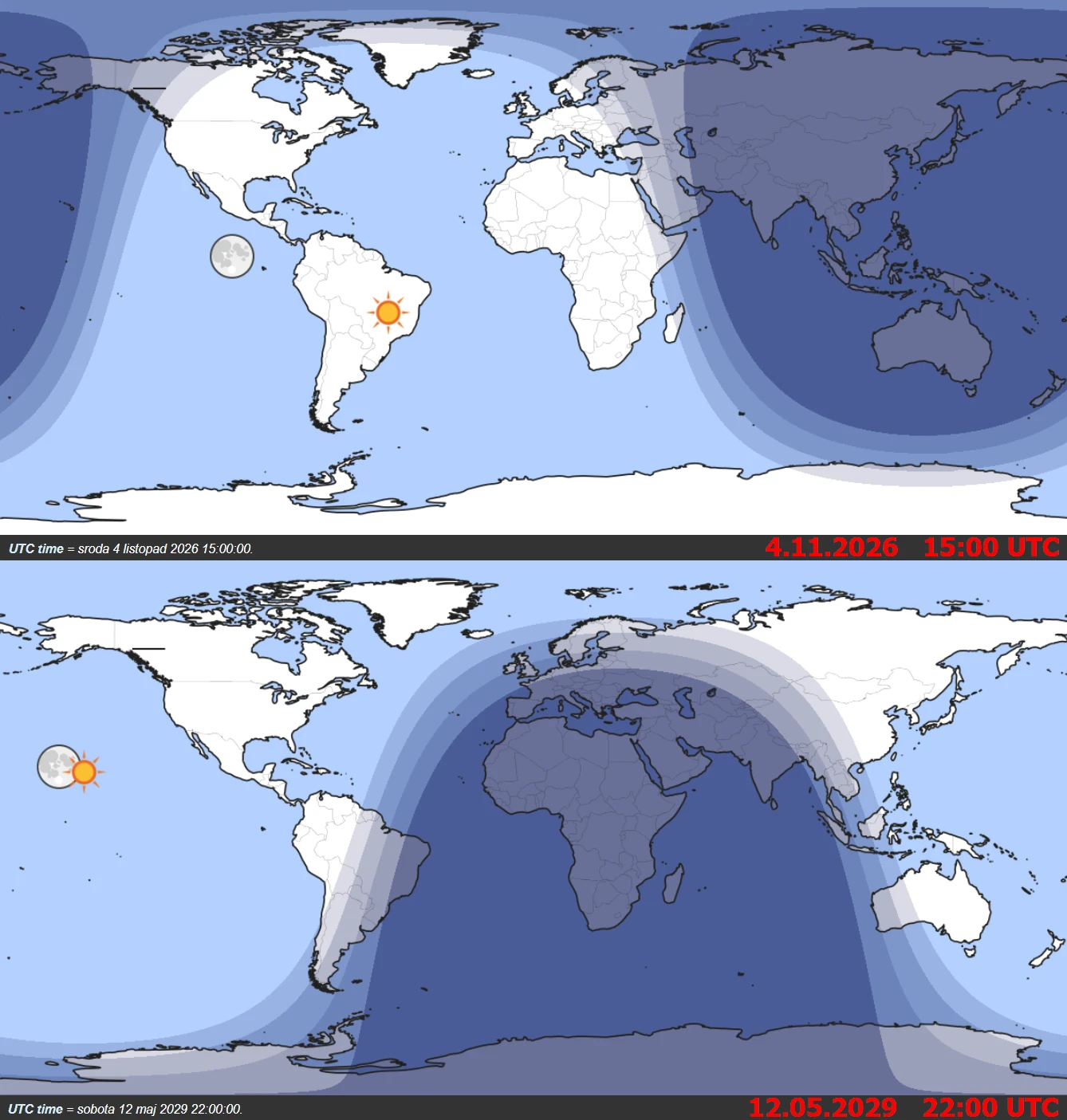
Pic. 64 The inferior conjunction of Mercury in 2026 and 2029 with the possibility of seeing the planet with solar prominences in the background if the H-alpha filter is used – the moment of the closest approach of the planet to solar limb against the day & night map worldwide (Timeanddate.com).
15. THE “FACE” CONJUNCTION
The conjunctions, where more than 2 celestial bodies are involved happen quite often. Sometimes, when we use our imagination, the configuration of the planets accompanied by the Moon or some bright stars might resemble something interesting. There is one conjunction, which will definitely look like a face for about 3 hours, when the Moon passes Regulus from the south (Pic. 65) between 13:00 UTC and 16:00 UTC on November 30, 2026.

Pic. 65, 66 The “face” conjunction of Mars, Jupiter, Moon, and Regulus on November 30, 2026 (65) and the area of visibility between 13:00 and 16:00 UTC (Stellarium-web.org/Timeanddate.com).
16. THE MOST IMPORTANT SOLAR ECLIPSES (8.04.2024, 12/13.08.2026, 2.08.2027, 22.07.2028).
There are 4 solar eclipses worth attention to in 2021-2030 and all of them are total. Three of them are the longest in the 2021-2040 period. Another one is so unique because it will be accompanied by lots of events.
They are presented in the map below (Pic. 67)
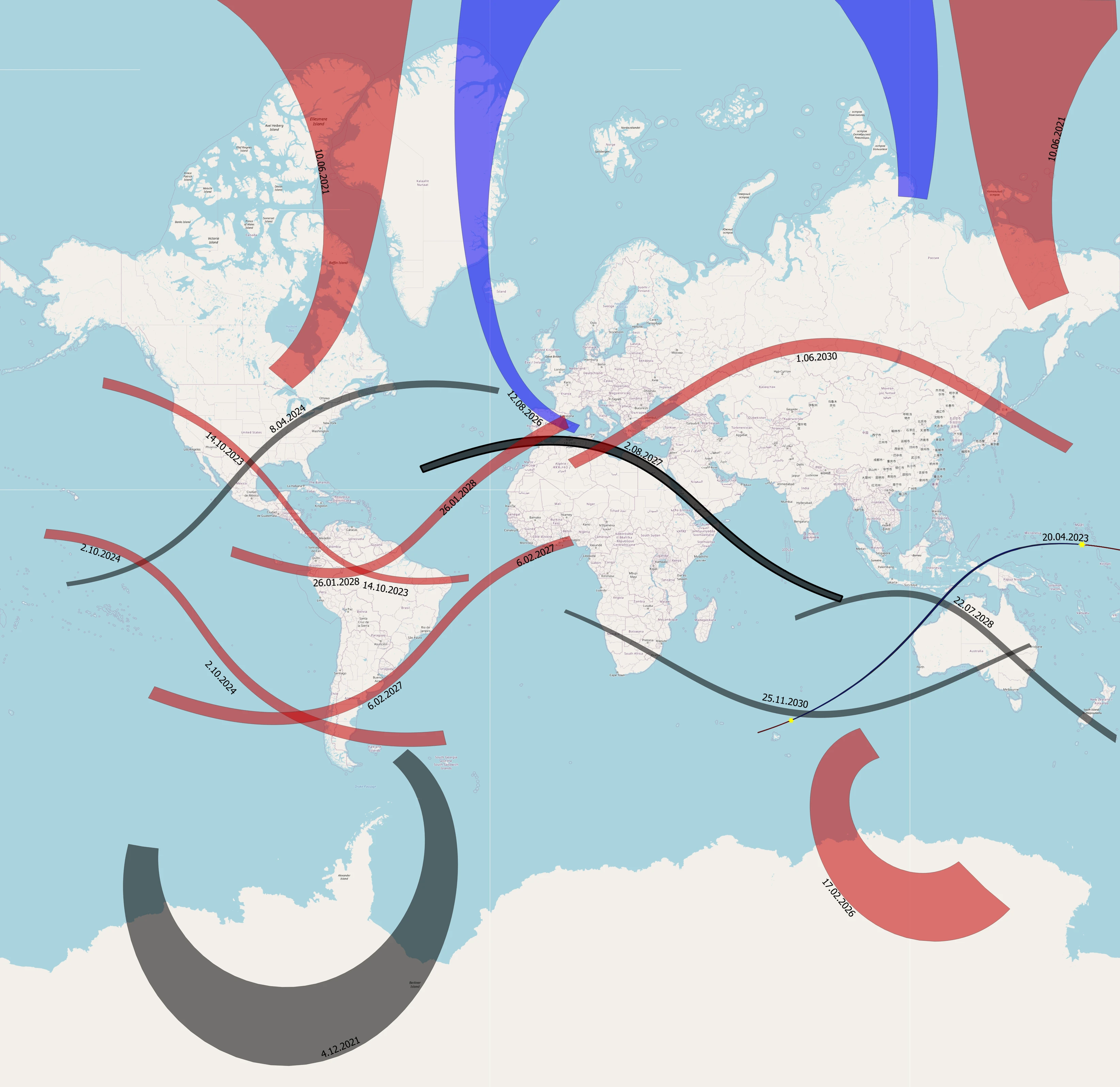
Pic. 67 The map of solar eclipses in the 2021-2030 period, where: red – annular solar eclipses; black – total solar eclipses; enhanced black – the longest total solar eclipse in the XXIst century on the ground; yellow symbol – hybrid solar eclipse; blue – the most interesting total solar eclipse accompanied by a lot of optical events (map based at Xjubbier.free.fr). Click to enlarge.
Apart from the Great American Eclipse on April 8, 2024, which will last 4m28s in Texas, there is another one on July 22, 2028, in Australia, with a duration of 5m10s in Western Australia. However, the most important will be the total solar eclipse on August 2, 2027, because of its duration of 6m22s. Let’s recall the longest total solar eclipse in the XXIst century, which occurred in July 2009 in China. Its duration was roughly 6m39s, but it could be gained from the seawater south of the Ogasawara Islands (Bonin Islands) just north of the Philippine Sea. The longest duration on land was east of Shanghai at the northernmost part of Zhoushan Archipelago (Dongkuaidao islet – 5m59s, Xiachuanshancun island – 5m58s). In 2027, the maximum duration falls in Egypt. It won’t be a problem to reach the venue, unlike in 2009, therefore this eclipse can be treated as the longest one in the XXIst century, which fairly happens on land (Pic. 68) since we can gain approximately another 25s of totality.
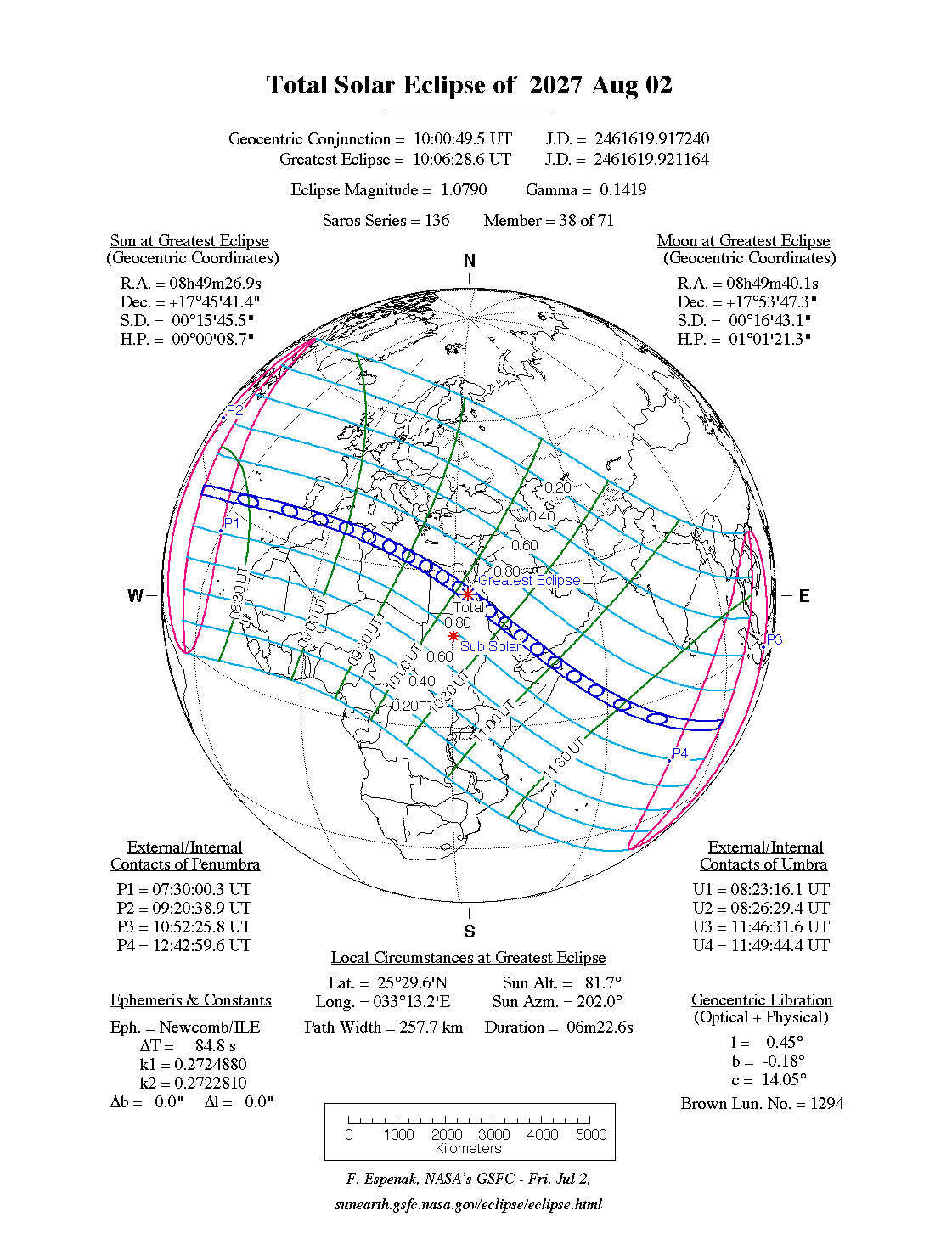
Pic. 68 The circumstances of the 2027 total solar eclipse, which will be the longest total solar eclipse in the XXIst century on land (Eclipse.gfsc.nasa.gov).
On top of that, the Sahara in Egypt statistically records 94% of days of sunshine annually. This magnificent value will definitely make this eclipse successful! You can start to plan your eclipse journey even now! As a good help and confirmation of the matter said just before, study this article about long-term planning of astronomical expeditions. The same as the total solar eclipse a year earlier, which appears to be the most unique total solar eclipse until 2044, I guess. You can read about at least 12 optical reasons why the 2026 eclipse is worth seeing.
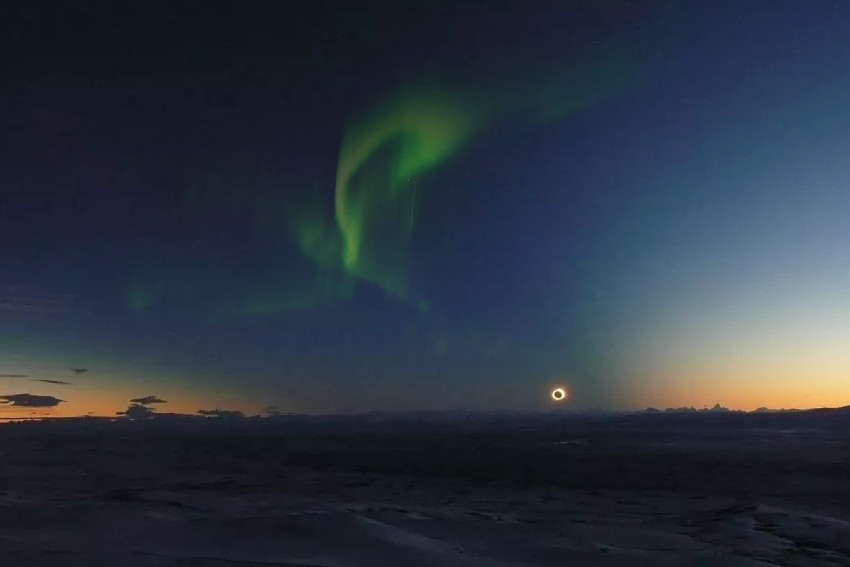
Pic. 69 The visualization of aurora occurrence at the same time when totality occurs. This is an assumed view from the eastern part of Taymyr Penninsula, where totality falls at midnight sun on August 12/13 2026.
There is also a hybrid solar eclipse within this period, although the rough overlap of the Sun by lunar disk will occur at sea body. First in the Indian Ocean northeast of the Kerguelen Islands, the second one in the Pacific Ocean, south of the Marshall Islands.
17. VENUS IN PLEIADES (4.04.2028) AND NEAR REGULUS (3.10.2028)
The conjunction of Venus with the Pleiades cluster belongs to the descending-node transits orbit and is related to June transits across the Sun, which happened previously. The journey of the brightest planet across the M45 cluster falls every 8 years between 2020 and 2060. This topic has been widely undertaken here. Next time, we will enjoy Venus in the Pleiades on April 3-4, 2028. April 4 is the day when Venus passes the Meropa star as close as 1-1,5′ (Pic. 70) depending on location worldwide. The southern hemisphere will experience greater conjunction, where will be hard to distinguish these 2 bodies by the naked eye.
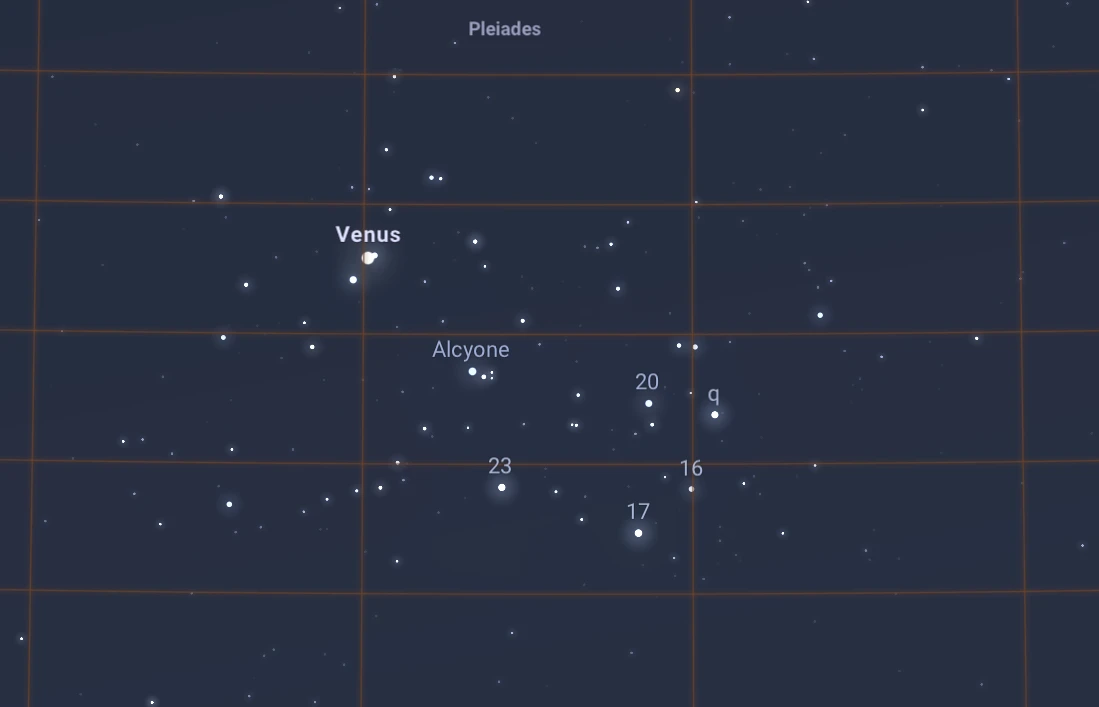
Pic. 70 Venus in the Pleiades and “great” conjunction with Meropa star on April 4, 2028 (Stellarium-web.org).
Another interesting approach to the brightest planet falls later in the Leo constellation. Venus meets Regulus on October 3, 2028 (Pic. 71) and every 8 years approaches closer to this star. In 2044 Venus will occult Regulus, which happened recently in 1959 (Pic. 72).
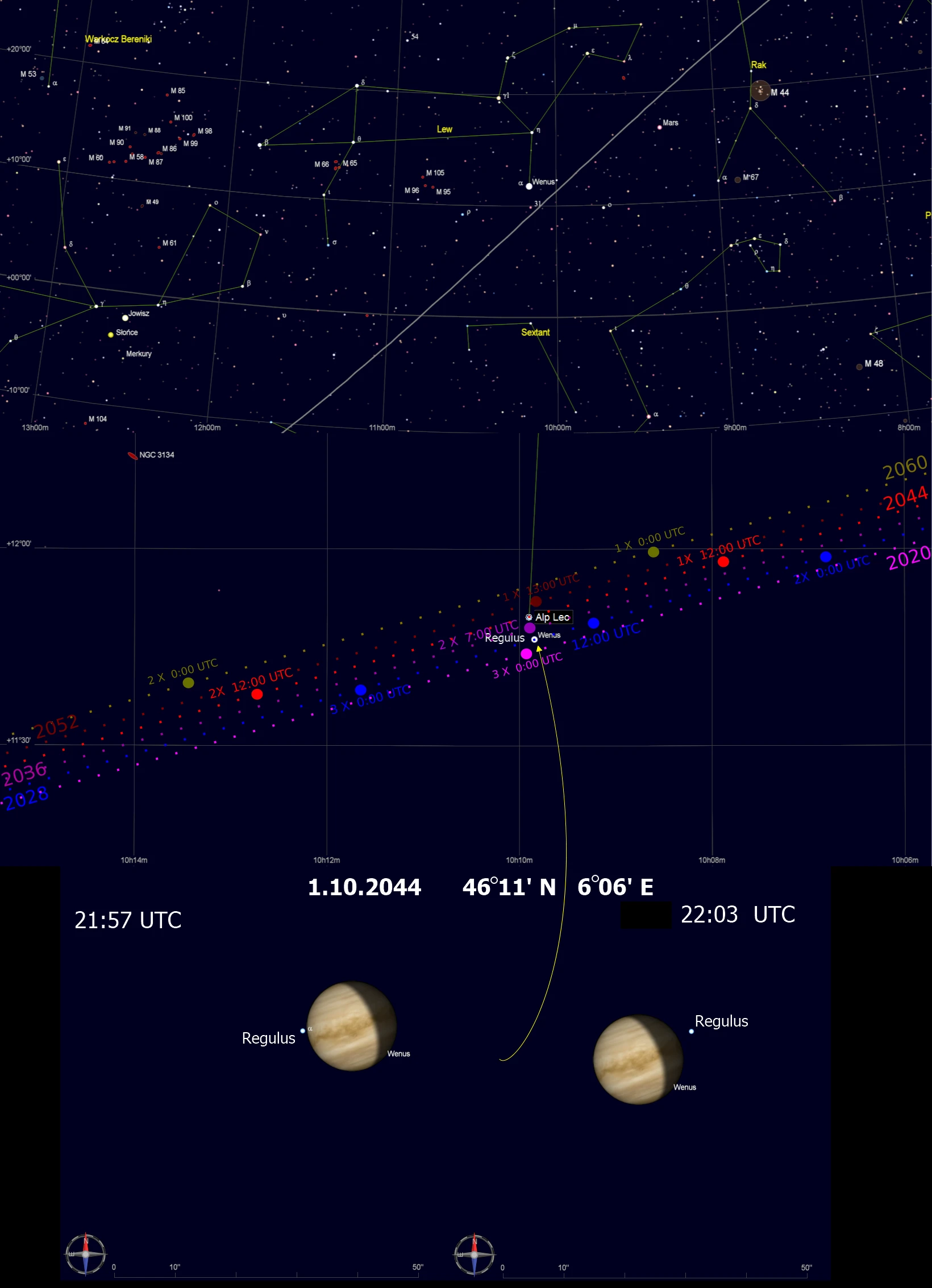
Pic. 71, 72 The close approach of Venus to Regulus on October 3, 2028, and other “great” conjunctions between AD 2020 and 2060 including also the occultation of Regulus in 2044 (Cartes du Ciel Sky Charts 4.21).
There are also other close conjunctions of Venus with quite bright stars like Pi Saggitari (17.02.2027), Rho Saggitari (22.02.2030), Zavijava (13.08.2021, 13.08.2029), and others, which we can calculate from this list.
18. 99942 APOPHIS CLOSE APPROACH (13.04.2029)
99942 Apophis is a near-Earth asteroid, classified as a potentially hazardous asteroid for our planet. Its diameter is 370-450m (Pic. 73). When it was discovered in 2004 there were a lot of concerns about its impact on Earth in 2029, which would reach as much as 2,7% probability. It was finally excluded in 2006 as well as the next approach of this asteroid, estimated in 2036.

Pic. 73 The dimensions of 99942 Apophis in relation to New York downtown (Planetary.org).
The close approach of 99942 Apophis is estimated to occur on April 13, 2029, with the minimum distance of this object to the Earth’s surface – being less than 32000 km (20000 miles). It means, that the object will be closer than geostationary communication satellites, making this asteroid the closest of its size in recorded history. From an observer’s point of view, the important is the brightness of this asteroid, which could determine the possibility of tracking this object across the Sky. The peak of brightness is expected around 20:30 UTC, where the asteroid should reach 3.1 Mag and be visible to the naked eye from rural areas (Pic. 74). At the earliest, the asteroid is estimated to be visible from Australia, next above the Indian Ocean, Africa, Atlantic Ocean, and finally North America. At the closest approach, the asteroid will pass the Atlantic Ocean.
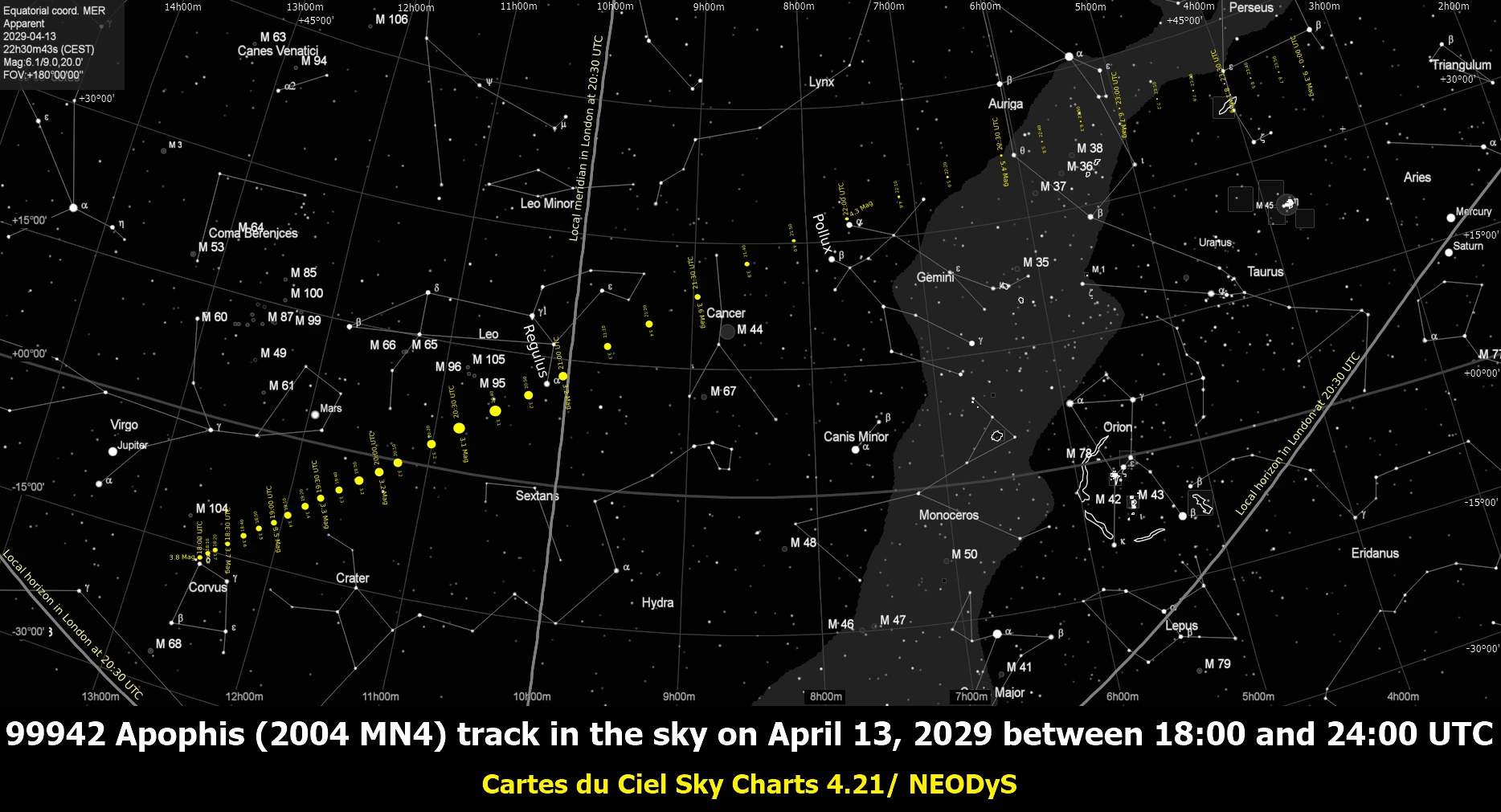
Pic. 74 The 99942 Apophis (2004 MN4) asteroid track in the sky on April 13, 2029, between 18:00 and 24:00 UTC. The brightest moment will fall around 20:30 and 20:40 UTC with a peak of 3.1 Mag. Interesting is also another 30 min later when the asteroid will pass the Regulus star closely (Cartes du Ciel Sky Charts 4.21/Neodys).
Scientists wonder about the possibility of destroying orbital satellites by this asteroid.
19. LARGEST TOTAL LUNAR ECLIPSE OF XXIst CENTURY (26.06.2029)
The June 29, 2029, total lunar eclipse is the central lunar eclipse type. It means, that the Moon passes through the center of Earth’s shadow (Westfall, Sheehan, 2014). As a result, the eclipsed lunar disk appears to look significantly darker than during other lunar eclipses. The key features of these eclipses are long duration, big magnitude, and very small value of Gamma. The list provided here includes quite a lot of lunar eclipses classified as central, with magnitudes higher than 1.4. My goal in this chapter is to mention these total lunar eclipses, whose magnitude is higher than 1.7. For the sake of simplification, we can assume here, that for an eclipse magnitude such as this, the deepest Earth’s shadow passes exactly or almost exactly at the center of the lunar disk at the moment of the greatest eclipse. The eclipsed Moon appears in the sky as a brown ring with a dark hole in the middle. This is obviously a far-reaching simplification for the purpose of this general article only. The exact determination of the central lunar eclipse criteria requires an additional study, which I am also going to undertake in the future. By now, we just need to know, that total lunar eclipses with a magnitude higher than 1.7 don’t occur so often. We can observe them at most once a decade, although usually every 18.6 years. Recently the largest total lunar eclipse we could observe was on June 15, 2011, with a magnitude of 1.7 exactly. The next one like this will occur on June 26, 2029, and will be the largest total lunar eclipse in the XXIst century, where umbral magnitude will reach 1.84 (Pic. 75).
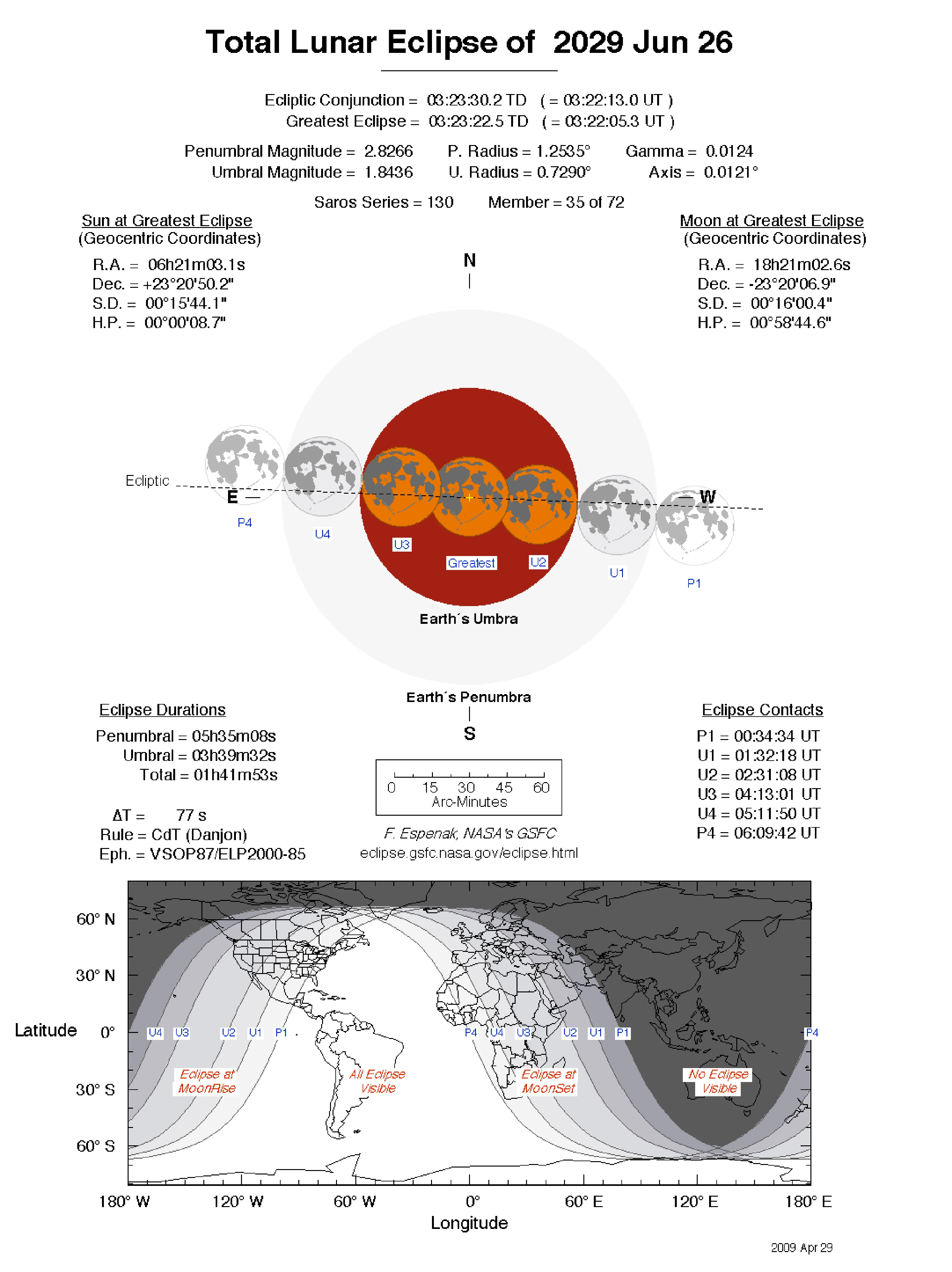
Pic. 75 The largest total lunar eclipse in XXIst century circumstances (Eclipse.gsfc.nasa.gov). Click to enlarge.
The next total lunar eclipse almost the same large as this will occur on July 7, 2047.
20. VENUS AND MARS ACCOMPANIED BY MOON AND MILKY WAY (9.11.2029)
The most beautiful conjunction in the 2021-2030 decade will occur on November 9, 2029, when the crescent Moon will pass Venus and Mars traveling across the Milky Way in Saggitarius (Pic. 76). A configuration such as this is not often at all, especially if we include passing crescent, Moon. Considering the Venus and Mars pairing occurs in a series, called the Venus-Mars 32 years cycle. Some of the series might be as long as 1200 years, and other few are shorter than 32 years. The next situation such as here will occur in 2061 when Mars will meet Venus in Saggitarius and the crescent Moon will pass by. 2 years earlier Venus will approach closer than 30′ to Mars but without lunar companionship.
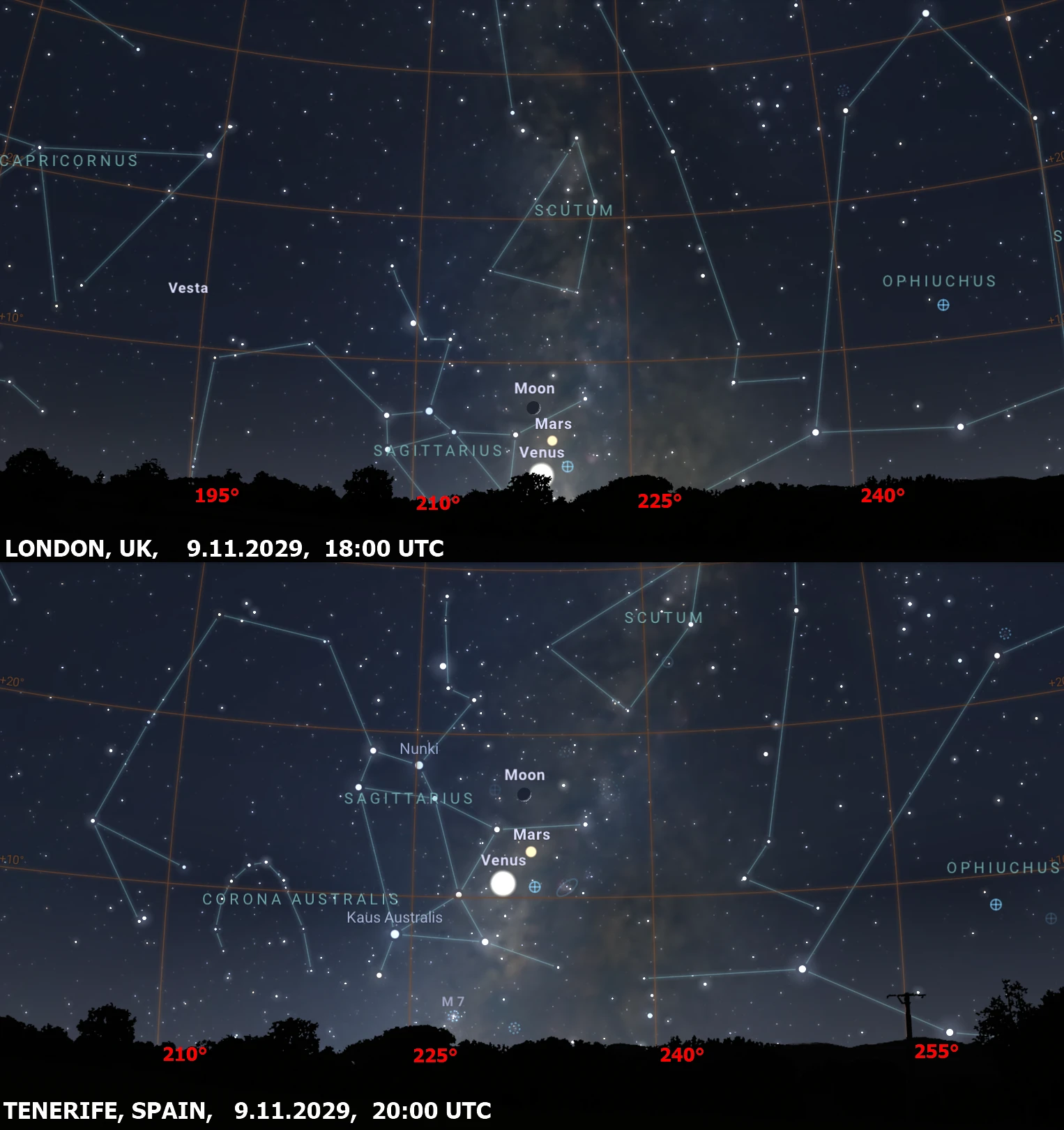
Pic. 76 The conjunction of Venus and Mars in the Milky Way with the crescent Moon passing by on November 9, 2029 (Stellarium-web.org).
Unfortunately, the northern hemisphere won’t be a good place to enjoy this configuration, because everything will happen in the Saggitarius constellation no longer than 2.5 hours after sunset. A much better view can be gained from tropic latitudes.
21. SUMMARY
The 2021-2030 decade abounds in various interesting celestial events, displaced worldwide. They were pretty much classified into groups of occurrences, similar to each other. The phenomena are mostly repeatable, but usually visible in different parts of the globe usually. It stresses the rarity of the given celestial event. Other events are possible to see in wider areas but occur only once or at most twice a decade. Each type of occurrence is unique. The most interesting seems to be all conjunctions of planets with other night sky objects (stars, clusters). The planet conjunctions are also interesting, but they are too common to be described widely here. I focused only on the greatest conjunctions possible to watch throughout this time, where the human eye won’t be capable of separating them from each other. These conjunctions are predominantly moments of the biggest planetary meeting in the sky, hence their areas of visibility are restricted. The rarity of these conjunctions as well as other types of astronomical events put some expeditions into consideration. The abundance of events described in this article prompts discussion about expanding the “great” astronomical expeditions, being focused mostly on solar eclipses and auroras so far. Travel agents should consider the journey also in terms of other celestial events concerned in this article. Their rarity across the globe prompts us to make some long-term planning of the expedition, where admittedly, mostly the weather and climate of the destination place should be concerned. This article will definitely help you to plan the journey to the potential observation place.
All the celestial maps presented in this writing are tailored for general insight only, by indicating to you the certain date and place, where the observation conditions will be the best. The events presented here don’t include the lunar occultations of stars. It will be discussed later, together with a lunar standstill. The season of lunar occultations of stars begins in 2023.
I hope, that this whole work will be helpful across the current decade. If you need to know more about celestial events on a day-to-day basis, I would recommend you take a look at this blog, which is one of the best guides for the sky on a daily basis.
Mariusz Krukar
References:
- Westfall J., Sheehan W., 2014, Celestial Shadows: Eclipses, Transits, and Occultations, Springer, New York
Links:
- Mutual planetary conjunctions and occultations
- 5 planets in the sky at once 21.07.2020
- Jupiter and Neptune transits 1800-2100
- https://www.planetary.org/articles/06031044-oppositions-conjunctions-rpx
- Unusual astronomical alignments
- When is the next great comet?
- Notable upcoming comets
- Comet of the week: 12P/Pons – Brooks
- Mutual Galilean satellites occultations
- Planetary Alignments: Fact or Fiction?
- All about conjunctions
- Happy Saturn ring plane crossing day!
- The Ecliptic: the Sun’s Annual Path on the Celestial Sphere
- Lunar standstills
- More about lunar standstills
- The major lunar standstills of 2006 & 2024-25
- http://www.seasky.org/astronomy/astronomy-calendar-2024.html
- Astropixels.com: Monthly lunar standstills 2001-2100
- http://www.seasky.org/astronomy/astronomy-calendar-2025.html
- https://www.greatamericaneclipse.com/
- https://www.nasa.gov/feature/jpl/nasa-analysis-earth-is-safe-from-asteroid-apophis-for-100-plus-years
- (99942) Apophis – detailed circumstances for April 13, 2029
- Predicting Apophis’ Earth Encounters in 2029 and 2036
- http://www.brera.mi.astro.it/sormano/Apophis/moid_apophis.html
- https://www.planetary.org/articles/will-apophis-hit-earth
- https://www.space.com/asteroid-apophis-2029-flyby-planetary-defense.html
- Asteroid Apophis will flyby Earth on April 13, 2029: Here’s why NASA is already preparing for it
- https://www.space.com/asteroid-apophis-2029-flyby-planetary-defense.html
- Planetary defense plan activated: astronomers appeal to observe Apophis asteroid, which will graze Earth in 2029 and 2068
- Timeanddate.com: Day & Night world map
- Timeanddate.com: Moonlight world map
- https://www.obliquity.com/skyeye/misc/ringcrossing.html
Forums:
Wiki:
- 12P/Pons–Brooks
- 99942_Apophis
- Apparent_retrograde_motion
- Beehive_Cluster
- Conjunction_(astronomy)
- Ecliptic
- List_of_central_lunar_eclipses
- List_of_future_astronomical_events
- List_of_Halley-type_comets
- List_of_periodic_comets
- Lunar_node
- Lunar_precession
- Lunar_standstill
- Occultation
- Planetary_transits_and_occultations
- Rings_of_Saturn
- Triple_conjunction
Youtube:

